Operations and Project Management: A Case Study on Operations Management Principles and Continuous Improvement Plan for Tesco
VerifiedAdded on 2023/06/18
|21
|5382
|352
AI Summary
This report covers the effectiveness of operations management principles and the concept of continuous improvement in an operational context for Tesco. It includes a review and critique of the implementation of operations management principles, analysis of the extent to which the operations management of the organisation meets the requirements, and a continuous improvement plan.
Contribute Materials
Your contribution can guide someone’s learning journey. Share your
documents today.
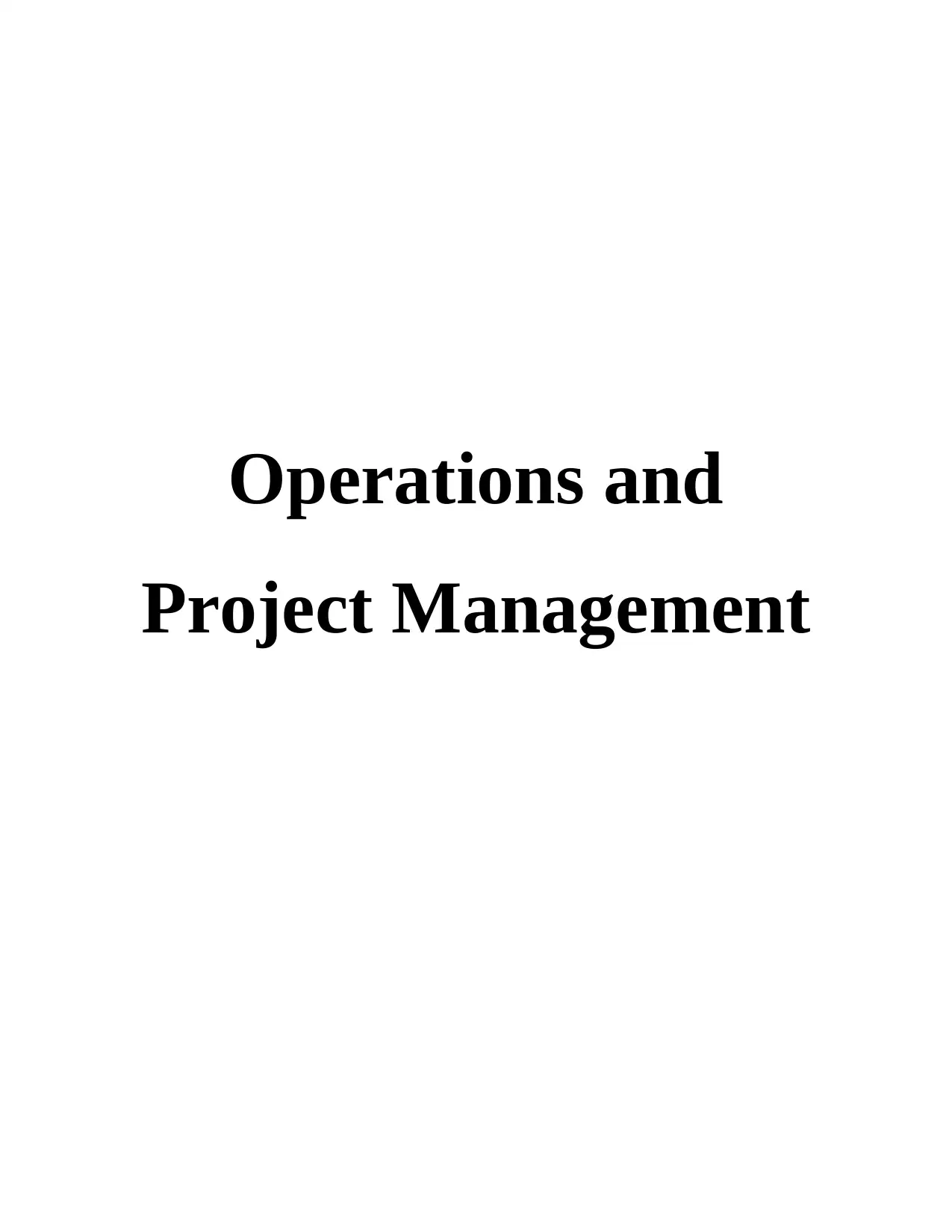
Operations and
Project Management
Project Management
Secure Best Marks with AI Grader
Need help grading? Try our AI Grader for instant feedback on your assignments.
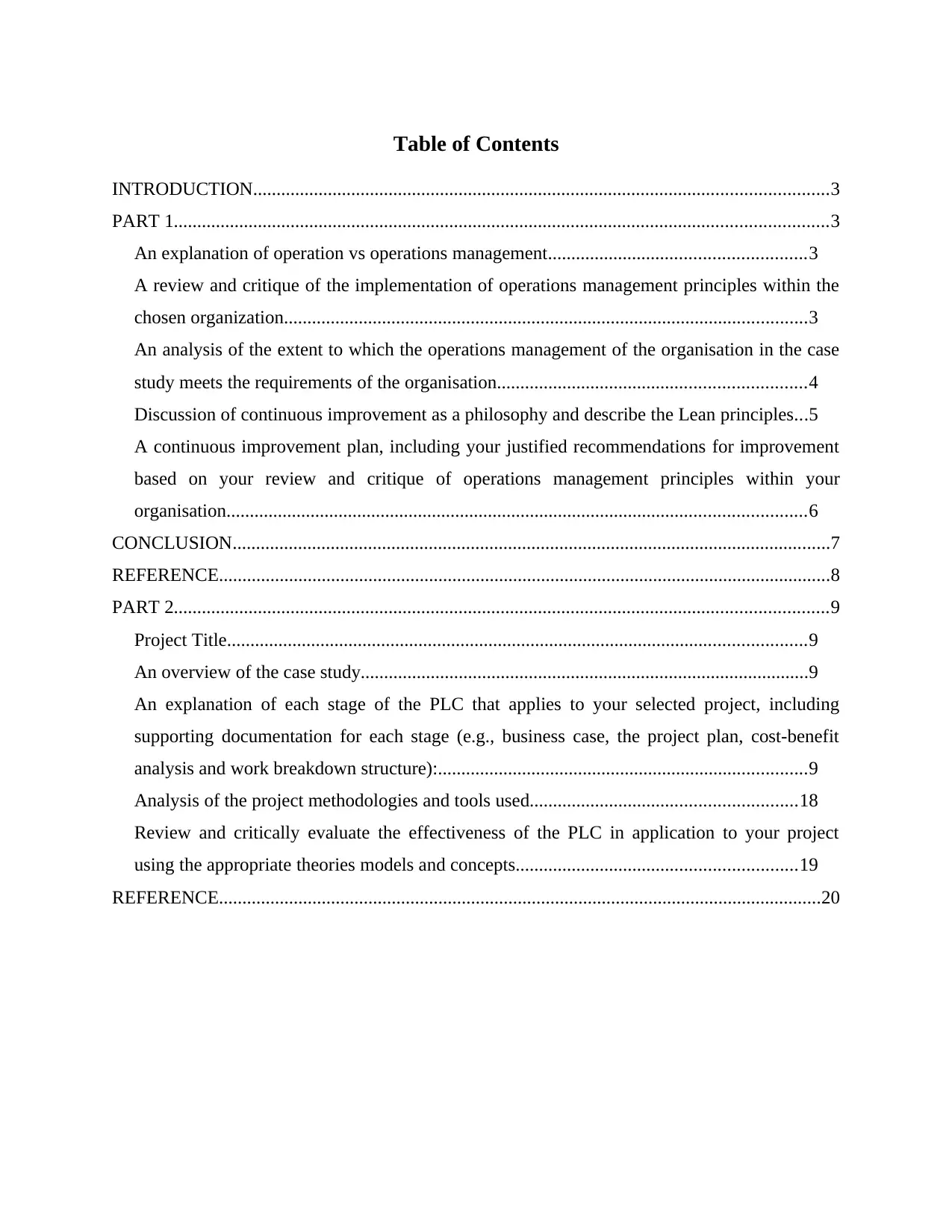
Table of Contents
INTRODUCTION...........................................................................................................................3
PART 1............................................................................................................................................3
An explanation of operation vs operations management.......................................................3
A review and critique of the implementation of operations management principles within the
chosen organization................................................................................................................3
An analysis of the extent to which the operations management of the organisation in the case
study meets the requirements of the organisation..................................................................4
Discussion of continuous improvement as a philosophy and describe the Lean principles...5
A continuous improvement plan, including your justified recommendations for improvement
based on your review and critique of operations management principles within your
organisation............................................................................................................................6
CONCLUSION................................................................................................................................7
REFERENCE...................................................................................................................................8
PART 2............................................................................................................................................9
Project Title............................................................................................................................9
An overview of the case study................................................................................................9
An explanation of each stage of the PLC that applies to your selected project, including
supporting documentation for each stage (e.g., business case, the project plan, cost-benefit
analysis and work breakdown structure):...............................................................................9
Analysis of the project methodologies and tools used.........................................................18
Review and critically evaluate the effectiveness of the PLC in application to your project
using the appropriate theories models and concepts............................................................19
REFERENCE.................................................................................................................................20
INTRODUCTION...........................................................................................................................3
PART 1............................................................................................................................................3
An explanation of operation vs operations management.......................................................3
A review and critique of the implementation of operations management principles within the
chosen organization................................................................................................................3
An analysis of the extent to which the operations management of the organisation in the case
study meets the requirements of the organisation..................................................................4
Discussion of continuous improvement as a philosophy and describe the Lean principles...5
A continuous improvement plan, including your justified recommendations for improvement
based on your review and critique of operations management principles within your
organisation............................................................................................................................6
CONCLUSION................................................................................................................................7
REFERENCE...................................................................................................................................8
PART 2............................................................................................................................................9
Project Title............................................................................................................................9
An overview of the case study................................................................................................9
An explanation of each stage of the PLC that applies to your selected project, including
supporting documentation for each stage (e.g., business case, the project plan, cost-benefit
analysis and work breakdown structure):...............................................................................9
Analysis of the project methodologies and tools used.........................................................18
Review and critically evaluate the effectiveness of the PLC in application to your project
using the appropriate theories models and concepts............................................................19
REFERENCE.................................................................................................................................20
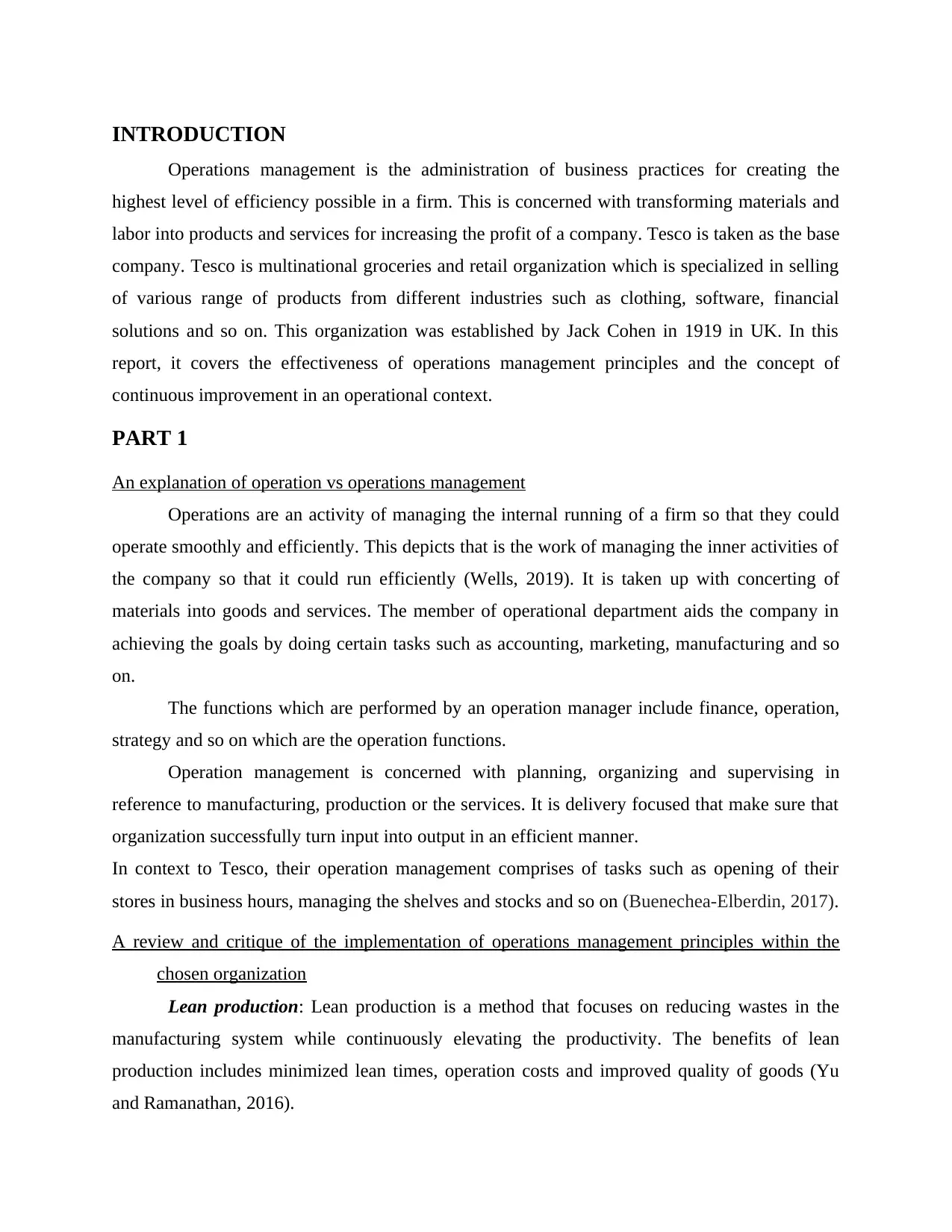
INTRODUCTION
Operations management is the administration of business practices for creating the
highest level of efficiency possible in a firm. This is concerned with transforming materials and
labor into products and services for increasing the profit of a company. Tesco is taken as the base
company. Tesco is multinational groceries and retail organization which is specialized in selling
of various range of products from different industries such as clothing, software, financial
solutions and so on. This organization was established by Jack Cohen in 1919 in UK. In this
report, it covers the effectiveness of operations management principles and the concept of
continuous improvement in an operational context.
PART 1
An explanation of operation vs operations management
Operations are an activity of managing the internal running of a firm so that they could
operate smoothly and efficiently. This depicts that is the work of managing the inner activities of
the company so that it could run efficiently (Wells, 2019). It is taken up with concerting of
materials into goods and services. The member of operational department aids the company in
achieving the goals by doing certain tasks such as accounting, marketing, manufacturing and so
on.
The functions which are performed by an operation manager include finance, operation,
strategy and so on which are the operation functions.
Operation management is concerned with planning, organizing and supervising in
reference to manufacturing, production or the services. It is delivery focused that make sure that
organization successfully turn input into output in an efficient manner.
In context to Tesco, their operation management comprises of tasks such as opening of their
stores in business hours, managing the shelves and stocks and so on (Buenechea-Elberdin, 2017).
A review and critique of the implementation of operations management principles within the
chosen organization
Lean production: Lean production is a method that focuses on reducing wastes in the
manufacturing system while continuously elevating the productivity. The benefits of lean
production includes minimized lean times, operation costs and improved quality of goods (Yu
and Ramanathan, 2016).
Operations management is the administration of business practices for creating the
highest level of efficiency possible in a firm. This is concerned with transforming materials and
labor into products and services for increasing the profit of a company. Tesco is taken as the base
company. Tesco is multinational groceries and retail organization which is specialized in selling
of various range of products from different industries such as clothing, software, financial
solutions and so on. This organization was established by Jack Cohen in 1919 in UK. In this
report, it covers the effectiveness of operations management principles and the concept of
continuous improvement in an operational context.
PART 1
An explanation of operation vs operations management
Operations are an activity of managing the internal running of a firm so that they could
operate smoothly and efficiently. This depicts that is the work of managing the inner activities of
the company so that it could run efficiently (Wells, 2019). It is taken up with concerting of
materials into goods and services. The member of operational department aids the company in
achieving the goals by doing certain tasks such as accounting, marketing, manufacturing and so
on.
The functions which are performed by an operation manager include finance, operation,
strategy and so on which are the operation functions.
Operation management is concerned with planning, organizing and supervising in
reference to manufacturing, production or the services. It is delivery focused that make sure that
organization successfully turn input into output in an efficient manner.
In context to Tesco, their operation management comprises of tasks such as opening of their
stores in business hours, managing the shelves and stocks and so on (Buenechea-Elberdin, 2017).
A review and critique of the implementation of operations management principles within the
chosen organization
Lean production: Lean production is a method that focuses on reducing wastes in the
manufacturing system while continuously elevating the productivity. The benefits of lean
production includes minimized lean times, operation costs and improved quality of goods (Yu
and Ramanathan, 2016).
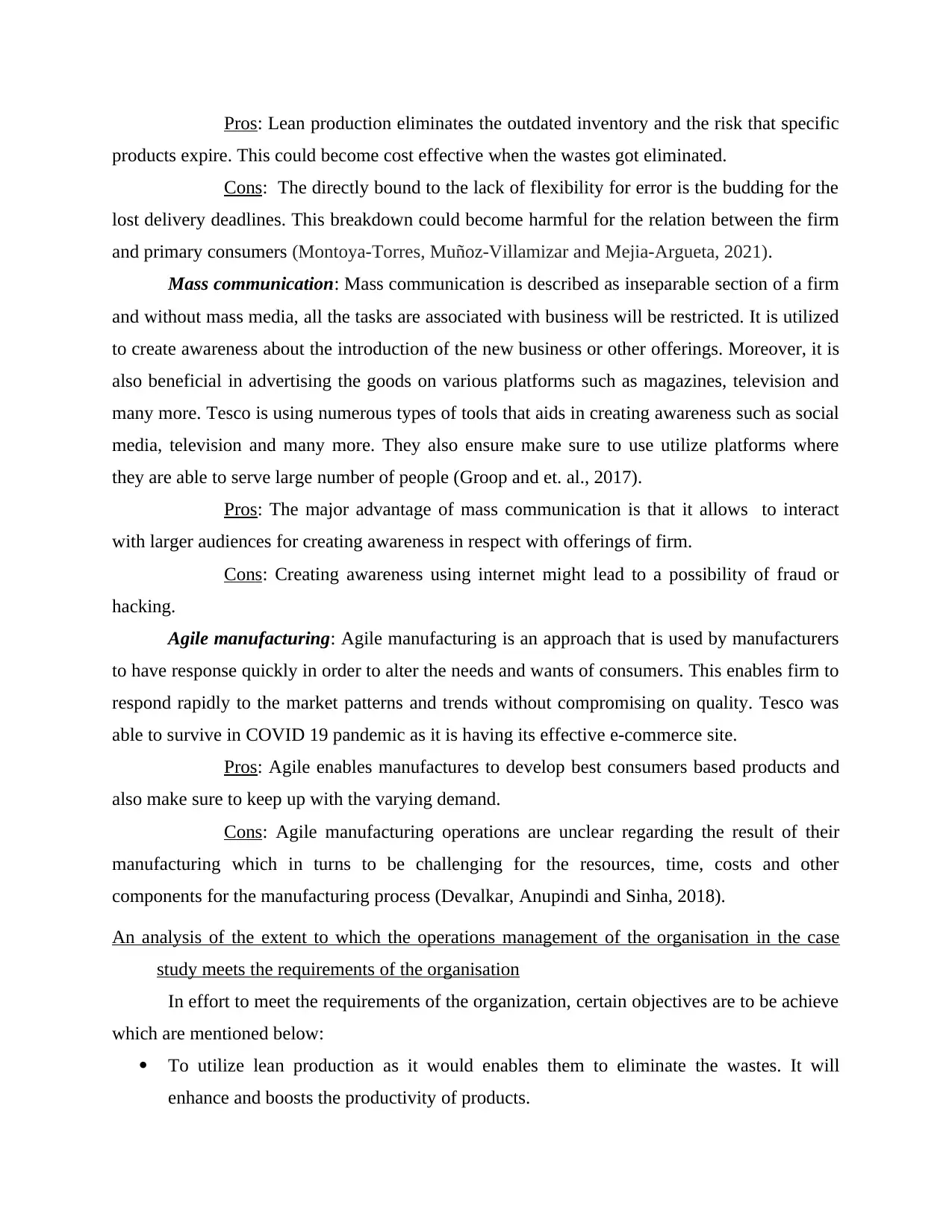
Pros: Lean production eliminates the outdated inventory and the risk that specific
products expire. This could become cost effective when the wastes got eliminated.
Cons: The directly bound to the lack of flexibility for error is the budding for the
lost delivery deadlines. This breakdown could become harmful for the relation between the firm
and primary consumers (Montoya-Torres, Muñoz-Villamizar and Mejia-Argueta, 2021).
Mass communication: Mass communication is described as inseparable section of a firm
and without mass media, all the tasks are associated with business will be restricted. It is utilized
to create awareness about the introduction of the new business or other offerings. Moreover, it is
also beneficial in advertising the goods on various platforms such as magazines, television and
many more. Tesco is using numerous types of tools that aids in creating awareness such as social
media, television and many more. They also ensure make sure to use utilize platforms where
they are able to serve large number of people (Groop and et. al., 2017).
Pros: The major advantage of mass communication is that it allows to interact
with larger audiences for creating awareness in respect with offerings of firm.
Cons: Creating awareness using internet might lead to a possibility of fraud or
hacking.
Agile manufacturing: Agile manufacturing is an approach that is used by manufacturers
to have response quickly in order to alter the needs and wants of consumers. This enables firm to
respond rapidly to the market patterns and trends without compromising on quality. Tesco was
able to survive in COVID 19 pandemic as it is having its effective e-commerce site.
Pros: Agile enables manufactures to develop best consumers based products and
also make sure to keep up with the varying demand.
Cons: Agile manufacturing operations are unclear regarding the result of their
manufacturing which in turns to be challenging for the resources, time, costs and other
components for the manufacturing process (Devalkar, Anupindi and Sinha, 2018).
An analysis of the extent to which the operations management of the organisation in the case
study meets the requirements of the organisation
In effort to meet the requirements of the organization, certain objectives are to be achieve
which are mentioned below:
To utilize lean production as it would enables them to eliminate the wastes. It will
enhance and boosts the productivity of products.
products expire. This could become cost effective when the wastes got eliminated.
Cons: The directly bound to the lack of flexibility for error is the budding for the
lost delivery deadlines. This breakdown could become harmful for the relation between the firm
and primary consumers (Montoya-Torres, Muñoz-Villamizar and Mejia-Argueta, 2021).
Mass communication: Mass communication is described as inseparable section of a firm
and without mass media, all the tasks are associated with business will be restricted. It is utilized
to create awareness about the introduction of the new business or other offerings. Moreover, it is
also beneficial in advertising the goods on various platforms such as magazines, television and
many more. Tesco is using numerous types of tools that aids in creating awareness such as social
media, television and many more. They also ensure make sure to use utilize platforms where
they are able to serve large number of people (Groop and et. al., 2017).
Pros: The major advantage of mass communication is that it allows to interact
with larger audiences for creating awareness in respect with offerings of firm.
Cons: Creating awareness using internet might lead to a possibility of fraud or
hacking.
Agile manufacturing: Agile manufacturing is an approach that is used by manufacturers
to have response quickly in order to alter the needs and wants of consumers. This enables firm to
respond rapidly to the market patterns and trends without compromising on quality. Tesco was
able to survive in COVID 19 pandemic as it is having its effective e-commerce site.
Pros: Agile enables manufactures to develop best consumers based products and
also make sure to keep up with the varying demand.
Cons: Agile manufacturing operations are unclear regarding the result of their
manufacturing which in turns to be challenging for the resources, time, costs and other
components for the manufacturing process (Devalkar, Anupindi and Sinha, 2018).
An analysis of the extent to which the operations management of the organisation in the case
study meets the requirements of the organisation
In effort to meet the requirements of the organization, certain objectives are to be achieve
which are mentioned below:
To utilize lean production as it would enables them to eliminate the wastes. It will
enhance and boosts the productivity of products.
Secure Best Marks with AI Grader
Need help grading? Try our AI Grader for instant feedback on your assignments.
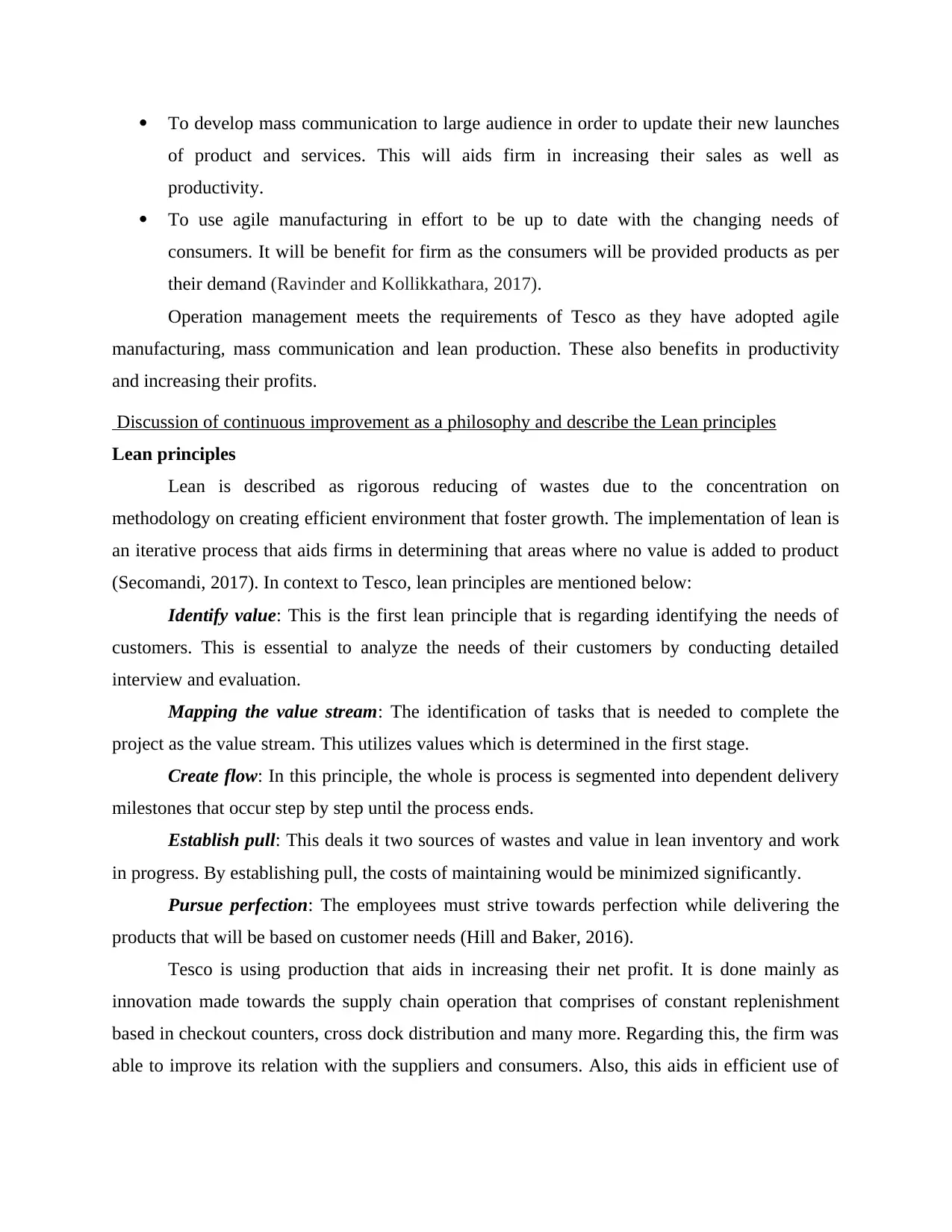
To develop mass communication to large audience in order to update their new launches
of product and services. This will aids firm in increasing their sales as well as
productivity.
To use agile manufacturing in effort to be up to date with the changing needs of
consumers. It will be benefit for firm as the consumers will be provided products as per
their demand (Ravinder and Kollikkathara, 2017).
Operation management meets the requirements of Tesco as they have adopted agile
manufacturing, mass communication and lean production. These also benefits in productivity
and increasing their profits.
Discussion of continuous improvement as a philosophy and describe the Lean principles
Lean principles
Lean is described as rigorous reducing of wastes due to the concentration on
methodology on creating efficient environment that foster growth. The implementation of lean is
an iterative process that aids firms in determining that areas where no value is added to product
(Secomandi, 2017). In context to Tesco, lean principles are mentioned below:
Identify value: This is the first lean principle that is regarding identifying the needs of
customers. This is essential to analyze the needs of their customers by conducting detailed
interview and evaluation.
Mapping the value stream: The identification of tasks that is needed to complete the
project as the value stream. This utilizes values which is determined in the first stage.
Create flow: In this principle, the whole is process is segmented into dependent delivery
milestones that occur step by step until the process ends.
Establish pull: This deals it two sources of wastes and value in lean inventory and work
in progress. By establishing pull, the costs of maintaining would be minimized significantly.
Pursue perfection: The employees must strive towards perfection while delivering the
products that will be based on customer needs (Hill and Baker, 2016).
Tesco is using production that aids in increasing their net profit. It is done mainly as
innovation made towards the supply chain operation that comprises of constant replenishment
based in checkout counters, cross dock distribution and many more. Regarding this, the firm was
able to improve its relation with the suppliers and consumers. Also, this aids in efficient use of
of product and services. This will aids firm in increasing their sales as well as
productivity.
To use agile manufacturing in effort to be up to date with the changing needs of
consumers. It will be benefit for firm as the consumers will be provided products as per
their demand (Ravinder and Kollikkathara, 2017).
Operation management meets the requirements of Tesco as they have adopted agile
manufacturing, mass communication and lean production. These also benefits in productivity
and increasing their profits.
Discussion of continuous improvement as a philosophy and describe the Lean principles
Lean principles
Lean is described as rigorous reducing of wastes due to the concentration on
methodology on creating efficient environment that foster growth. The implementation of lean is
an iterative process that aids firms in determining that areas where no value is added to product
(Secomandi, 2017). In context to Tesco, lean principles are mentioned below:
Identify value: This is the first lean principle that is regarding identifying the needs of
customers. This is essential to analyze the needs of their customers by conducting detailed
interview and evaluation.
Mapping the value stream: The identification of tasks that is needed to complete the
project as the value stream. This utilizes values which is determined in the first stage.
Create flow: In this principle, the whole is process is segmented into dependent delivery
milestones that occur step by step until the process ends.
Establish pull: This deals it two sources of wastes and value in lean inventory and work
in progress. By establishing pull, the costs of maintaining would be minimized significantly.
Pursue perfection: The employees must strive towards perfection while delivering the
products that will be based on customer needs (Hill and Baker, 2016).
Tesco is using production that aids in increasing their net profit. It is done mainly as
innovation made towards the supply chain operation that comprises of constant replenishment
based in checkout counters, cross dock distribution and many more. Regarding this, the firm was
able to improve its relation with the suppliers and consumers. Also, this aids in efficient use of
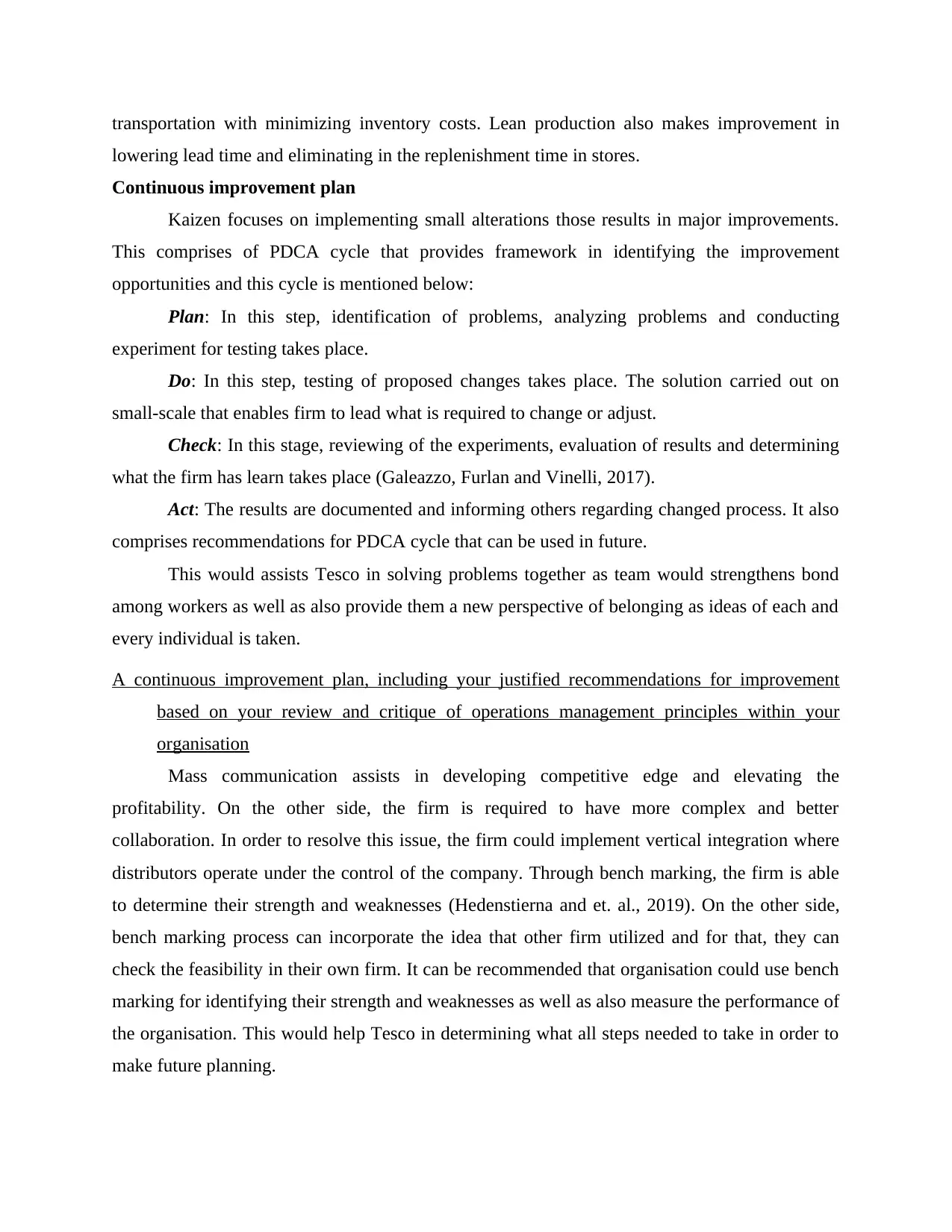
transportation with minimizing inventory costs. Lean production also makes improvement in
lowering lead time and eliminating in the replenishment time in stores.
Continuous improvement plan
Kaizen focuses on implementing small alterations those results in major improvements.
This comprises of PDCA cycle that provides framework in identifying the improvement
opportunities and this cycle is mentioned below:
Plan: In this step, identification of problems, analyzing problems and conducting
experiment for testing takes place.
Do: In this step, testing of proposed changes takes place. The solution carried out on
small-scale that enables firm to lead what is required to change or adjust.
Check: In this stage, reviewing of the experiments, evaluation of results and determining
what the firm has learn takes place (Galeazzo, Furlan and Vinelli, 2017).
Act: The results are documented and informing others regarding changed process. It also
comprises recommendations for PDCA cycle that can be used in future.
This would assists Tesco in solving problems together as team would strengthens bond
among workers as well as also provide them a new perspective of belonging as ideas of each and
every individual is taken.
A continuous improvement plan, including your justified recommendations for improvement
based on your review and critique of operations management principles within your
organisation
Mass communication assists in developing competitive edge and elevating the
profitability. On the other side, the firm is required to have more complex and better
collaboration. In order to resolve this issue, the firm could implement vertical integration where
distributors operate under the control of the company. Through bench marking, the firm is able
to determine their strength and weaknesses (Hedenstierna and et. al., 2019). On the other side,
bench marking process can incorporate the idea that other firm utilized and for that, they can
check the feasibility in their own firm. It can be recommended that organisation could use bench
marking for identifying their strength and weaknesses as well as also measure the performance of
the organisation. This would help Tesco in determining what all steps needed to take in order to
make future planning.
lowering lead time and eliminating in the replenishment time in stores.
Continuous improvement plan
Kaizen focuses on implementing small alterations those results in major improvements.
This comprises of PDCA cycle that provides framework in identifying the improvement
opportunities and this cycle is mentioned below:
Plan: In this step, identification of problems, analyzing problems and conducting
experiment for testing takes place.
Do: In this step, testing of proposed changes takes place. The solution carried out on
small-scale that enables firm to lead what is required to change or adjust.
Check: In this stage, reviewing of the experiments, evaluation of results and determining
what the firm has learn takes place (Galeazzo, Furlan and Vinelli, 2017).
Act: The results are documented and informing others regarding changed process. It also
comprises recommendations for PDCA cycle that can be used in future.
This would assists Tesco in solving problems together as team would strengthens bond
among workers as well as also provide them a new perspective of belonging as ideas of each and
every individual is taken.
A continuous improvement plan, including your justified recommendations for improvement
based on your review and critique of operations management principles within your
organisation
Mass communication assists in developing competitive edge and elevating the
profitability. On the other side, the firm is required to have more complex and better
collaboration. In order to resolve this issue, the firm could implement vertical integration where
distributors operate under the control of the company. Through bench marking, the firm is able
to determine their strength and weaknesses (Hedenstierna and et. al., 2019). On the other side,
bench marking process can incorporate the idea that other firm utilized and for that, they can
check the feasibility in their own firm. It can be recommended that organisation could use bench
marking for identifying their strength and weaknesses as well as also measure the performance of
the organisation. This would help Tesco in determining what all steps needed to take in order to
make future planning.
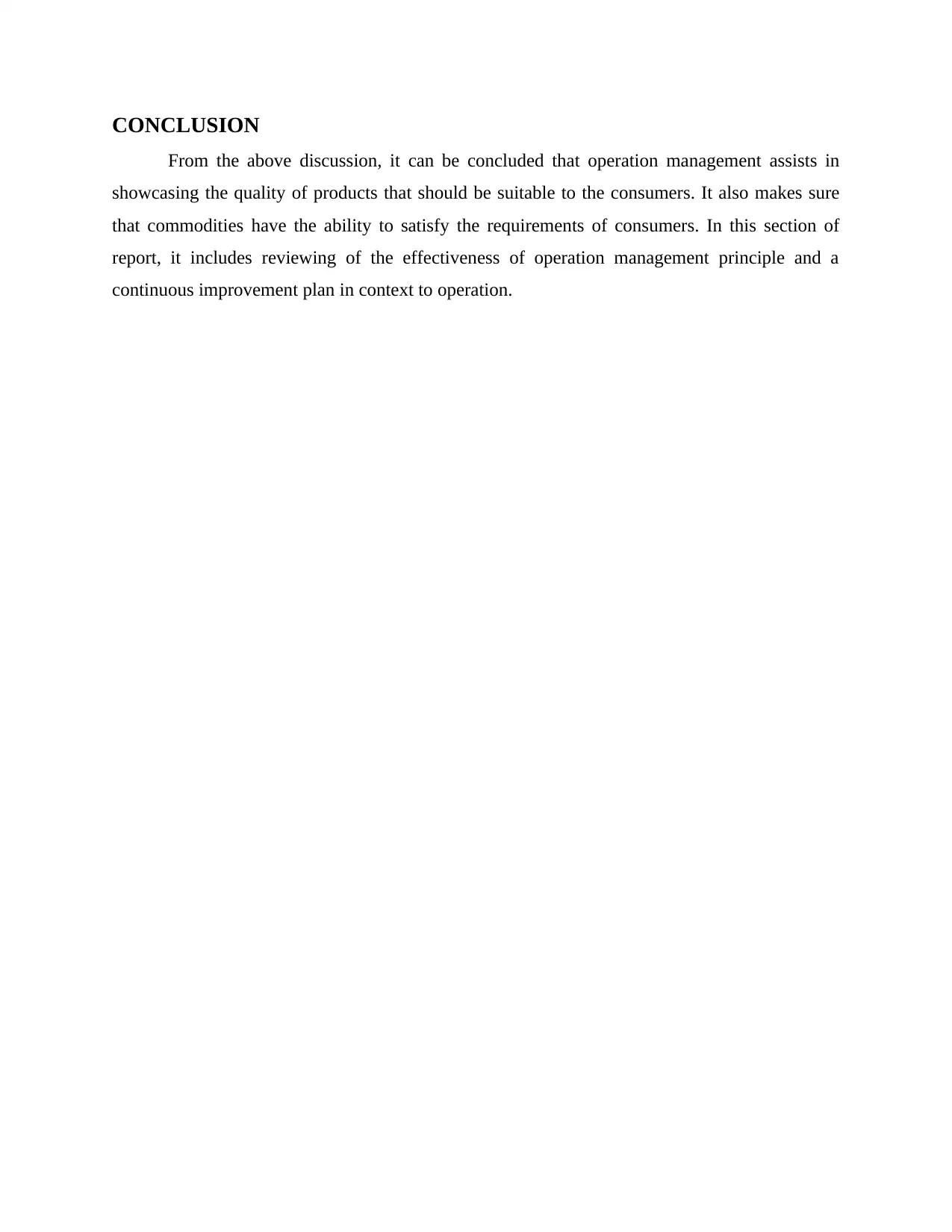
CONCLUSION
From the above discussion, it can be concluded that operation management assists in
showcasing the quality of products that should be suitable to the consumers. It also makes sure
that commodities have the ability to satisfy the requirements of consumers. In this section of
report, it includes reviewing of the effectiveness of operation management principle and a
continuous improvement plan in context to operation.
From the above discussion, it can be concluded that operation management assists in
showcasing the quality of products that should be suitable to the consumers. It also makes sure
that commodities have the ability to satisfy the requirements of consumers. In this section of
report, it includes reviewing of the effectiveness of operation management principle and a
continuous improvement plan in context to operation.
Paraphrase This Document
Need a fresh take? Get an instant paraphrase of this document with our AI Paraphraser
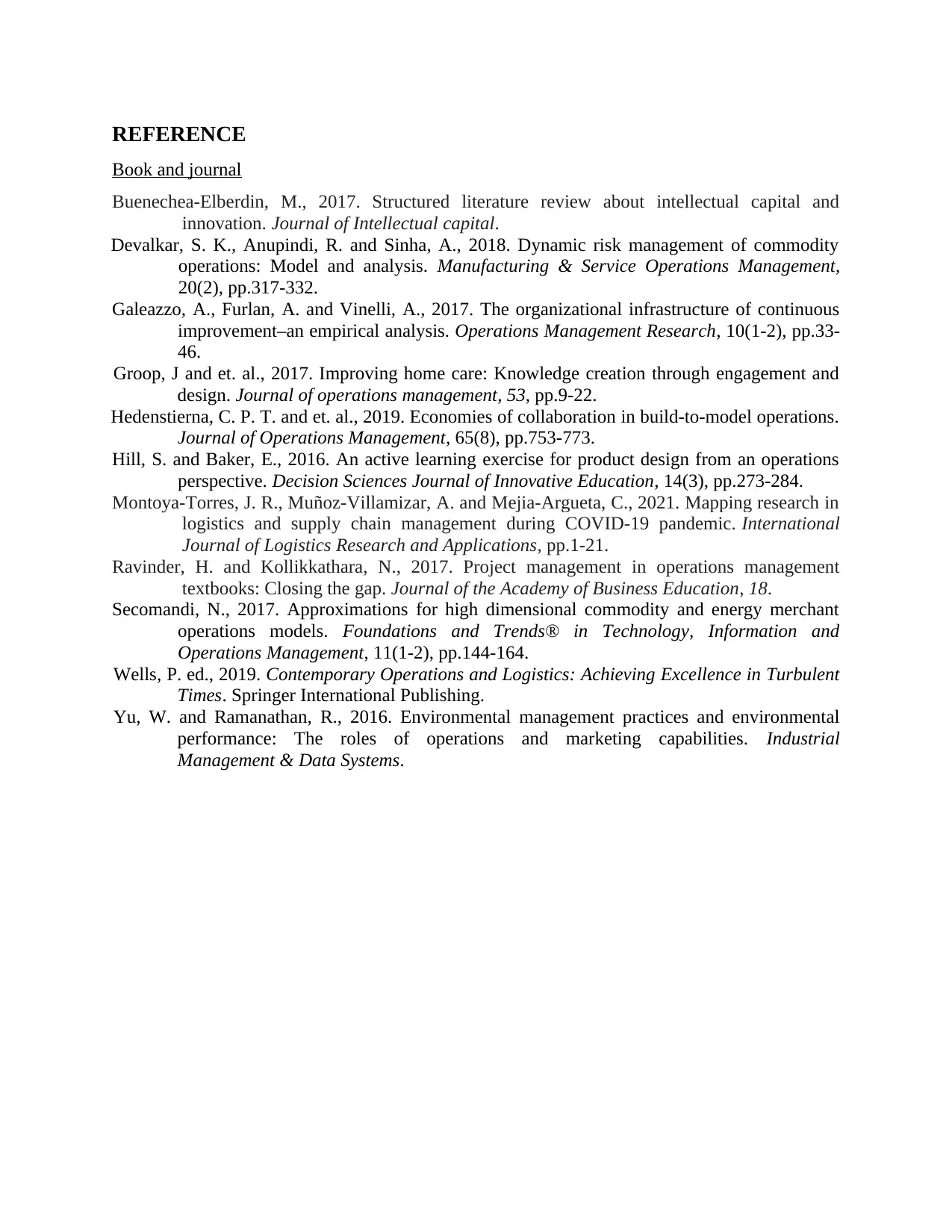
REFERENCE
Book and journal
Buenechea-Elberdin, M., 2017. Structured literature review about intellectual capital and
innovation. Journal of Intellectual capital.
Devalkar, S. K., Anupindi, R. and Sinha, A., 2018. Dynamic risk management of commodity
operations: Model and analysis. Manufacturing & Service Operations Management,
20(2), pp.317-332.
Galeazzo, A., Furlan, A. and Vinelli, A., 2017. The organizational infrastructure of continuous
improvement–an empirical analysis. Operations Management Research, 10(1-2), pp.33-
46.
Groop, J and et. al., 2017. Improving home care: Knowledge creation through engagement and
design. Journal of operations management, 53, pp.9-22.
Hedenstierna, C. P. T. and et. al., 2019. Economies of collaboration in build‐to‐model operations.
Journal of Operations Management, 65(8), pp.753-773.
Hill, S. and Baker, E., 2016. An active learning exercise for product design from an operations
perspective. Decision Sciences Journal of Innovative Education, 14(3), pp.273-284.
Montoya-Torres, J. R., Muñoz-Villamizar, A. and Mejia-Argueta, C., 2021. Mapping research in
logistics and supply chain management during COVID-19 pandemic. International
Journal of Logistics Research and Applications, pp.1-21.
Ravinder, H. and Kollikkathara, N., 2017. Project management in operations management
textbooks: Closing the gap. Journal of the Academy of Business Education, 18.
Secomandi, N., 2017. Approximations for high dimensional commodity and energy merchant
operations models. Foundations and Trends® in Technology, Information and
Operations Management, 11(1-2), pp.144-164.
Wells, P. ed., 2019. Contemporary Operations and Logistics: Achieving Excellence in Turbulent
Times. Springer International Publishing.
Yu, W. and Ramanathan, R., 2016. Environmental management practices and environmental
performance: The roles of operations and marketing capabilities. Industrial
Management & Data Systems.
Book and journal
Buenechea-Elberdin, M., 2017. Structured literature review about intellectual capital and
innovation. Journal of Intellectual capital.
Devalkar, S. K., Anupindi, R. and Sinha, A., 2018. Dynamic risk management of commodity
operations: Model and analysis. Manufacturing & Service Operations Management,
20(2), pp.317-332.
Galeazzo, A., Furlan, A. and Vinelli, A., 2017. The organizational infrastructure of continuous
improvement–an empirical analysis. Operations Management Research, 10(1-2), pp.33-
46.
Groop, J and et. al., 2017. Improving home care: Knowledge creation through engagement and
design. Journal of operations management, 53, pp.9-22.
Hedenstierna, C. P. T. and et. al., 2019. Economies of collaboration in build‐to‐model operations.
Journal of Operations Management, 65(8), pp.753-773.
Hill, S. and Baker, E., 2016. An active learning exercise for product design from an operations
perspective. Decision Sciences Journal of Innovative Education, 14(3), pp.273-284.
Montoya-Torres, J. R., Muñoz-Villamizar, A. and Mejia-Argueta, C., 2021. Mapping research in
logistics and supply chain management during COVID-19 pandemic. International
Journal of Logistics Research and Applications, pp.1-21.
Ravinder, H. and Kollikkathara, N., 2017. Project management in operations management
textbooks: Closing the gap. Journal of the Academy of Business Education, 18.
Secomandi, N., 2017. Approximations for high dimensional commodity and energy merchant
operations models. Foundations and Trends® in Technology, Information and
Operations Management, 11(1-2), pp.144-164.
Wells, P. ed., 2019. Contemporary Operations and Logistics: Achieving Excellence in Turbulent
Times. Springer International Publishing.
Yu, W. and Ramanathan, R., 2016. Environmental management practices and environmental
performance: The roles of operations and marketing capabilities. Industrial
Management & Data Systems.
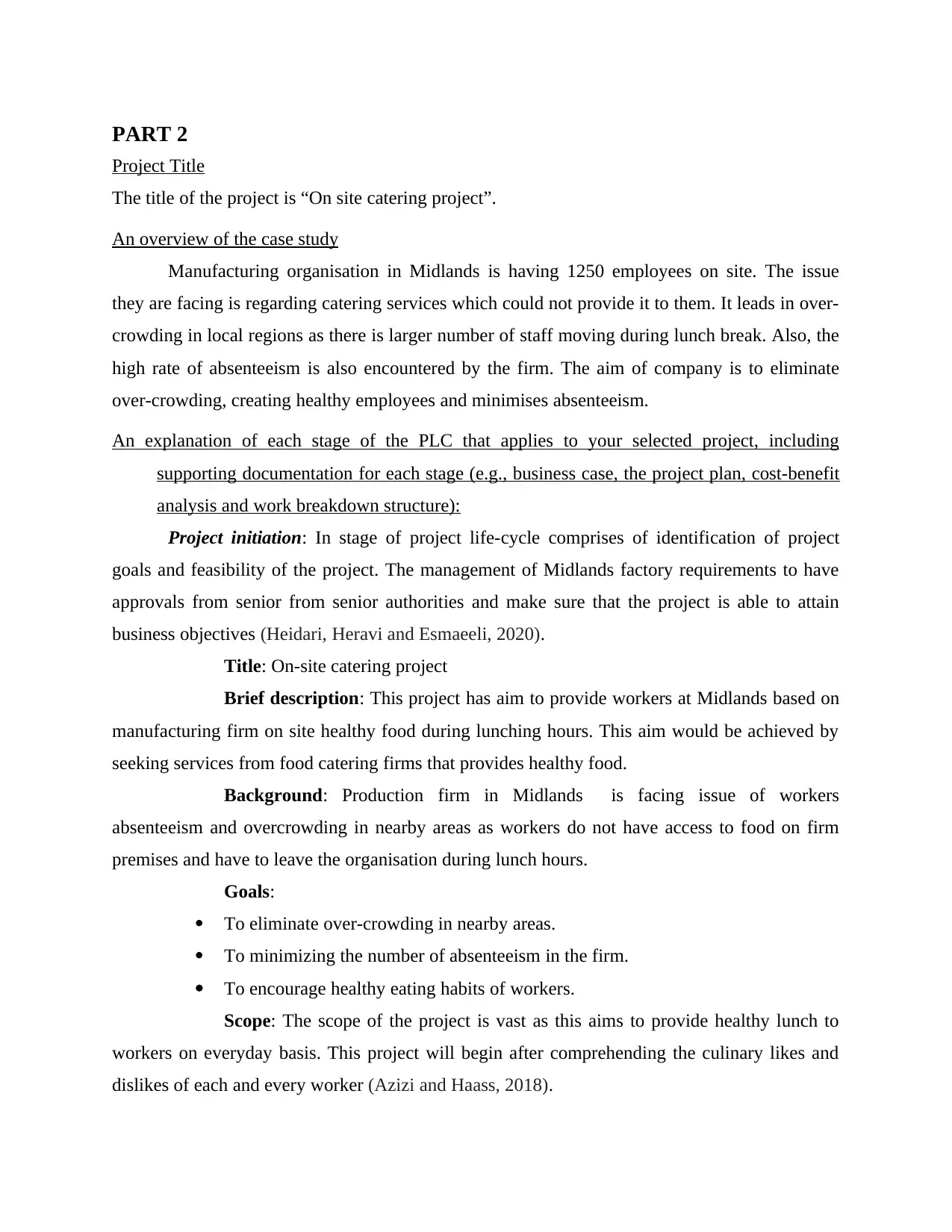
PART 2
Project Title
The title of the project is “On site catering project”.
An overview of the case study
Manufacturing organisation in Midlands is having 1250 employees on site. The issue
they are facing is regarding catering services which could not provide it to them. It leads in over-
crowding in local regions as there is larger number of staff moving during lunch break. Also, the
high rate of absenteeism is also encountered by the firm. The aim of company is to eliminate
over-crowding, creating healthy employees and minimises absenteeism.
An explanation of each stage of the PLC that applies to your selected project, including
supporting documentation for each stage (e.g., business case, the project plan, cost-benefit
analysis and work breakdown structure):
Project initiation: In stage of project life-cycle comprises of identification of project
goals and feasibility of the project. The management of Midlands factory requirements to have
approvals from senior from senior authorities and make sure that the project is able to attain
business objectives (Heidari, Heravi and Esmaeeli, 2020).
Title: On-site catering project
Brief description: This project has aim to provide workers at Midlands based on
manufacturing firm on site healthy food during lunching hours. This aim would be achieved by
seeking services from food catering firms that provides healthy food.
Background: Production firm in Midlands is facing issue of workers
absenteeism and overcrowding in nearby areas as workers do not have access to food on firm
premises and have to leave the organisation during lunch hours.
Goals:
To eliminate over-crowding in nearby areas.
To minimizing the number of absenteeism in the firm.
To encourage healthy eating habits of workers.
Scope: The scope of the project is vast as this aims to provide healthy lunch to
workers on everyday basis. This project will begin after comprehending the culinary likes and
dislikes of each and every worker (Azizi and Haass, 2018).
Project Title
The title of the project is “On site catering project”.
An overview of the case study
Manufacturing organisation in Midlands is having 1250 employees on site. The issue
they are facing is regarding catering services which could not provide it to them. It leads in over-
crowding in local regions as there is larger number of staff moving during lunch break. Also, the
high rate of absenteeism is also encountered by the firm. The aim of company is to eliminate
over-crowding, creating healthy employees and minimises absenteeism.
An explanation of each stage of the PLC that applies to your selected project, including
supporting documentation for each stage (e.g., business case, the project plan, cost-benefit
analysis and work breakdown structure):
Project initiation: In stage of project life-cycle comprises of identification of project
goals and feasibility of the project. The management of Midlands factory requirements to have
approvals from senior from senior authorities and make sure that the project is able to attain
business objectives (Heidari, Heravi and Esmaeeli, 2020).
Title: On-site catering project
Brief description: This project has aim to provide workers at Midlands based on
manufacturing firm on site healthy food during lunching hours. This aim would be achieved by
seeking services from food catering firms that provides healthy food.
Background: Production firm in Midlands is facing issue of workers
absenteeism and overcrowding in nearby areas as workers do not have access to food on firm
premises and have to leave the organisation during lunch hours.
Goals:
To eliminate over-crowding in nearby areas.
To minimizing the number of absenteeism in the firm.
To encourage healthy eating habits of workers.
Scope: The scope of the project is vast as this aims to provide healthy lunch to
workers on everyday basis. This project will begin after comprehending the culinary likes and
dislikes of each and every worker (Azizi and Haass, 2018).
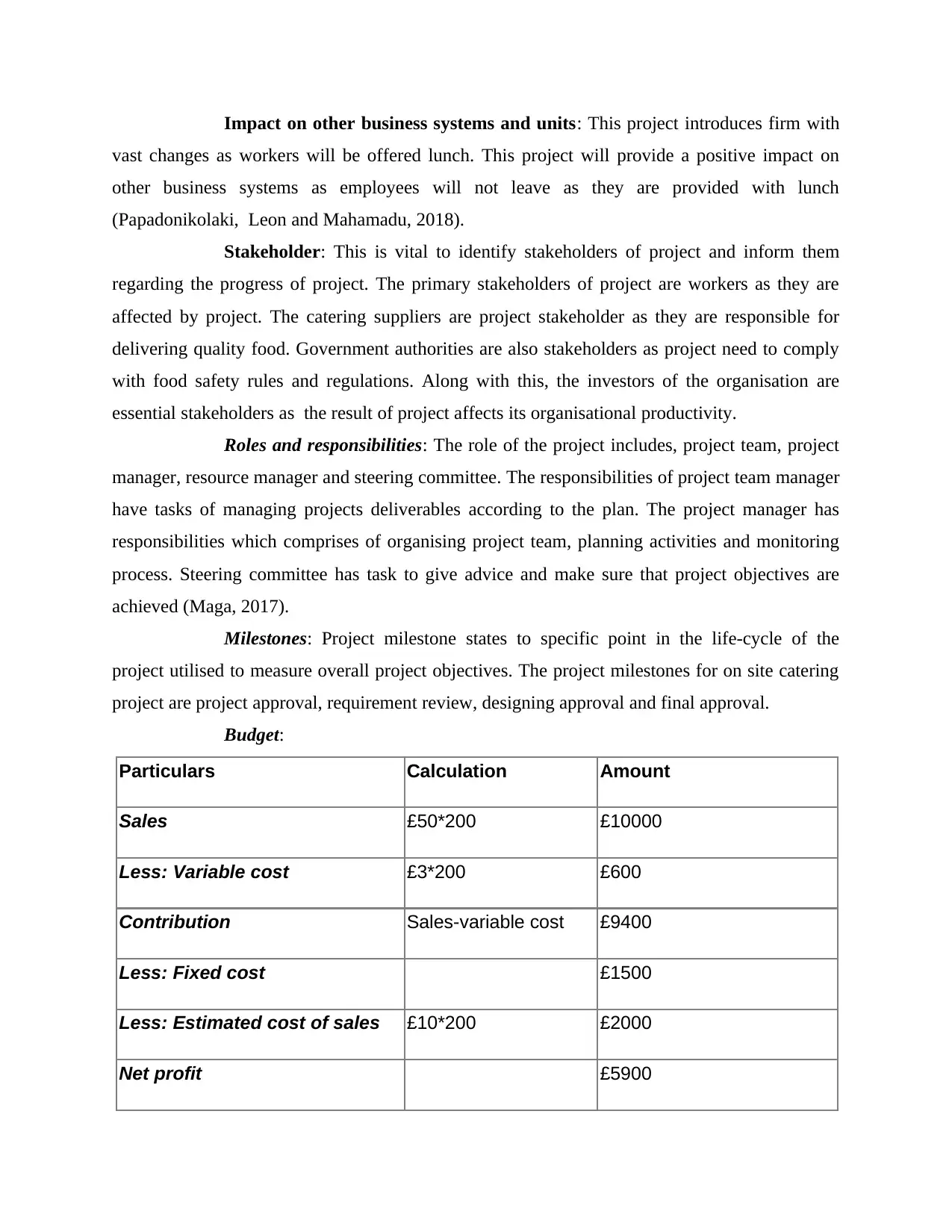
Impact on other business systems and units: This project introduces firm with
vast changes as workers will be offered lunch. This project will provide a positive impact on
other business systems as employees will not leave as they are provided with lunch
(Papadonikolaki, Leon and Mahamadu, 2018).
Stakeholder: This is vital to identify stakeholders of project and inform them
regarding the progress of project. The primary stakeholders of project are workers as they are
affected by project. The catering suppliers are project stakeholder as they are responsible for
delivering quality food. Government authorities are also stakeholders as project need to comply
with food safety rules and regulations. Along with this, the investors of the organisation are
essential stakeholders as the result of project affects its organisational productivity.
Roles and responsibilities: The role of the project includes, project team, project
manager, resource manager and steering committee. The responsibilities of project team manager
have tasks of managing projects deliverables according to the plan. The project manager has
responsibilities which comprises of organising project team, planning activities and monitoring
process. Steering committee has task to give advice and make sure that project objectives are
achieved (Maga, 2017).
Milestones: Project milestone states to specific point in the life-cycle of the
project utilised to measure overall project objectives. The project milestones for on site catering
project are project approval, requirement review, designing approval and final approval.
Budget:
Particulars Calculation Amount
Sales £50*200 £10000
Less: Variable cost £3*200 £600
Contribution Sales-variable cost £9400
Less: Fixed cost £1500
Less: Estimated cost of sales £10*200 £2000
Net profit £5900
vast changes as workers will be offered lunch. This project will provide a positive impact on
other business systems as employees will not leave as they are provided with lunch
(Papadonikolaki, Leon and Mahamadu, 2018).
Stakeholder: This is vital to identify stakeholders of project and inform them
regarding the progress of project. The primary stakeholders of project are workers as they are
affected by project. The catering suppliers are project stakeholder as they are responsible for
delivering quality food. Government authorities are also stakeholders as project need to comply
with food safety rules and regulations. Along with this, the investors of the organisation are
essential stakeholders as the result of project affects its organisational productivity.
Roles and responsibilities: The role of the project includes, project team, project
manager, resource manager and steering committee. The responsibilities of project team manager
have tasks of managing projects deliverables according to the plan. The project manager has
responsibilities which comprises of organising project team, planning activities and monitoring
process. Steering committee has task to give advice and make sure that project objectives are
achieved (Maga, 2017).
Milestones: Project milestone states to specific point in the life-cycle of the
project utilised to measure overall project objectives. The project milestones for on site catering
project are project approval, requirement review, designing approval and final approval.
Budget:
Particulars Calculation Amount
Sales £50*200 £10000
Less: Variable cost £3*200 £600
Contribution Sales-variable cost £9400
Less: Fixed cost £1500
Less: Estimated cost of sales £10*200 £2000
Net profit £5900
Secure Best Marks with AI Grader
Need help grading? Try our AI Grader for instant feedback on your assignments.
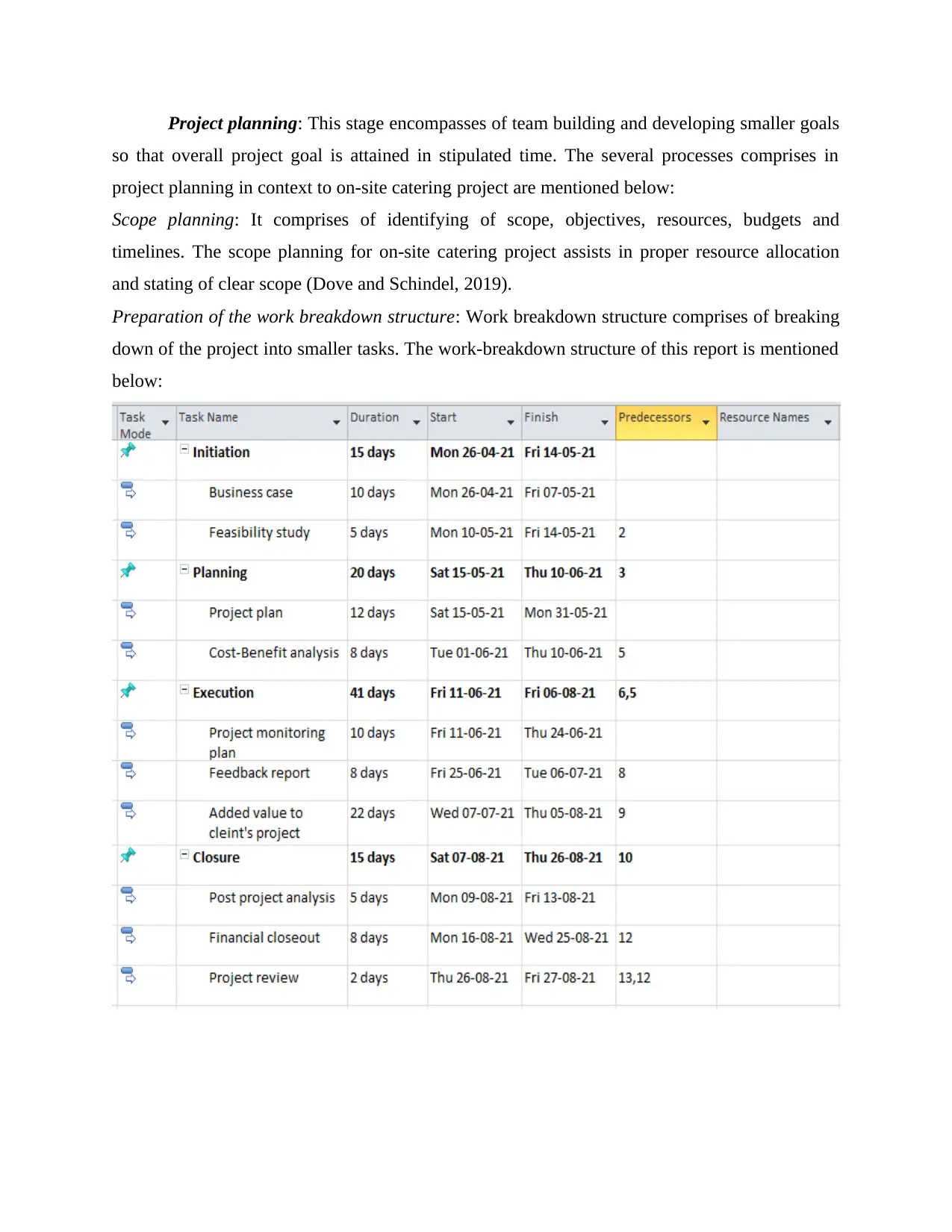
Project planning: This stage encompasses of team building and developing smaller goals
so that overall project goal is attained in stipulated time. The several processes comprises in
project planning in context to on-site catering project are mentioned below:
Scope planning: It comprises of identifying of scope, objectives, resources, budgets and
timelines. The scope planning for on-site catering project assists in proper resource allocation
and stating of clear scope (Dove and Schindel, 2019).
Preparation of the work breakdown structure: Work breakdown structure comprises of breaking
down of the project into smaller tasks. The work-breakdown structure of this report is mentioned
below:
so that overall project goal is attained in stipulated time. The several processes comprises in
project planning in context to on-site catering project are mentioned below:
Scope planning: It comprises of identifying of scope, objectives, resources, budgets and
timelines. The scope planning for on-site catering project assists in proper resource allocation
and stating of clear scope (Dove and Schindel, 2019).
Preparation of the work breakdown structure: Work breakdown structure comprises of breaking
down of the project into smaller tasks. The work-breakdown structure of this report is mentioned
below:
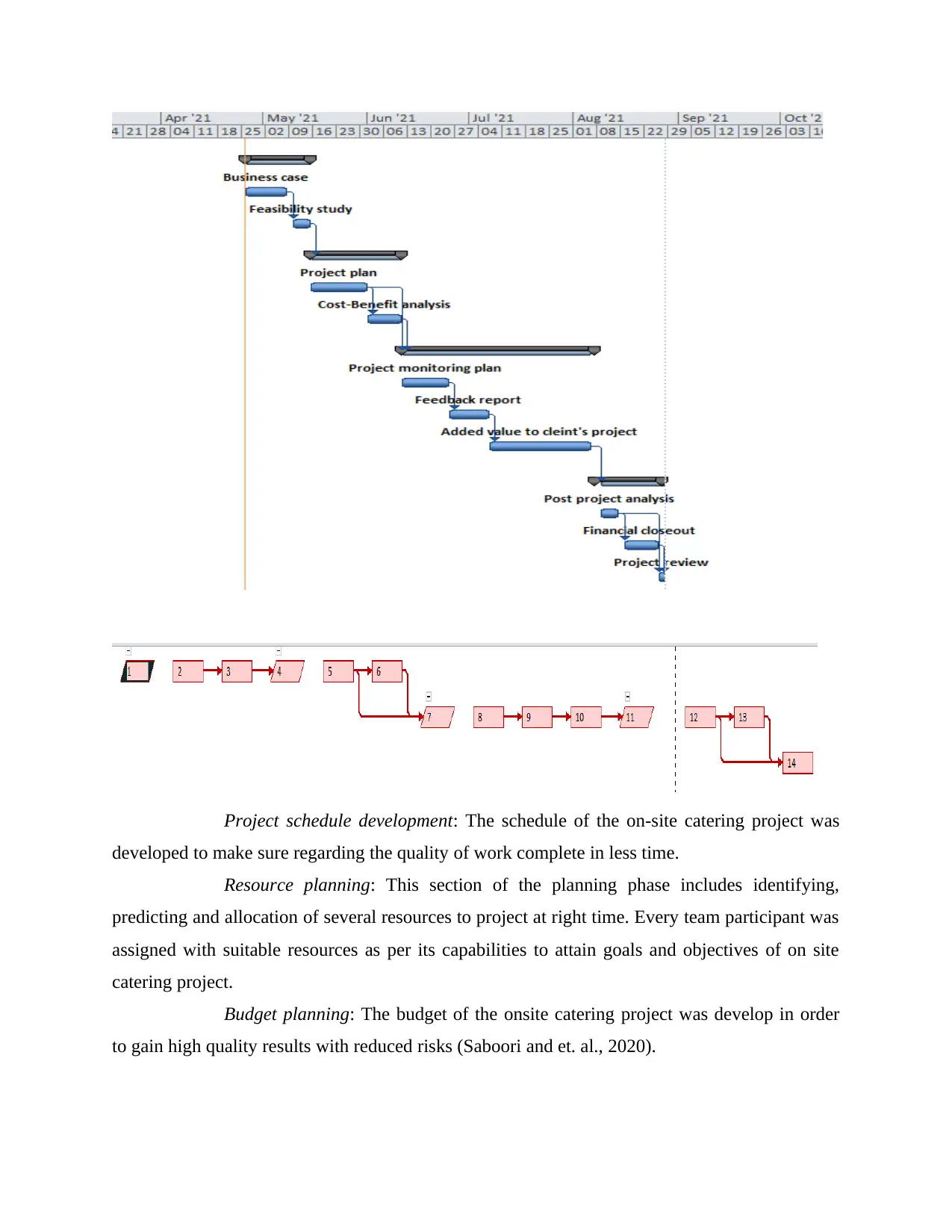
Project schedule development: The schedule of the on-site catering project was
developed to make sure regarding the quality of work complete in less time.
Resource planning: This section of the planning phase includes identifying,
predicting and allocation of several resources to project at right time. Every team participant was
assigned with suitable resources as per its capabilities to attain goals and objectives of on site
catering project.
Budget planning: The budget of the onsite catering project was develop in order
to gain high quality results with reduced risks (Saboori and et. al., 2020).
developed to make sure regarding the quality of work complete in less time.
Resource planning: This section of the planning phase includes identifying,
predicting and allocation of several resources to project at right time. Every team participant was
assigned with suitable resources as per its capabilities to attain goals and objectives of on site
catering project.
Budget planning: The budget of the onsite catering project was develop in order
to gain high quality results with reduced risks (Saboori and et. al., 2020).
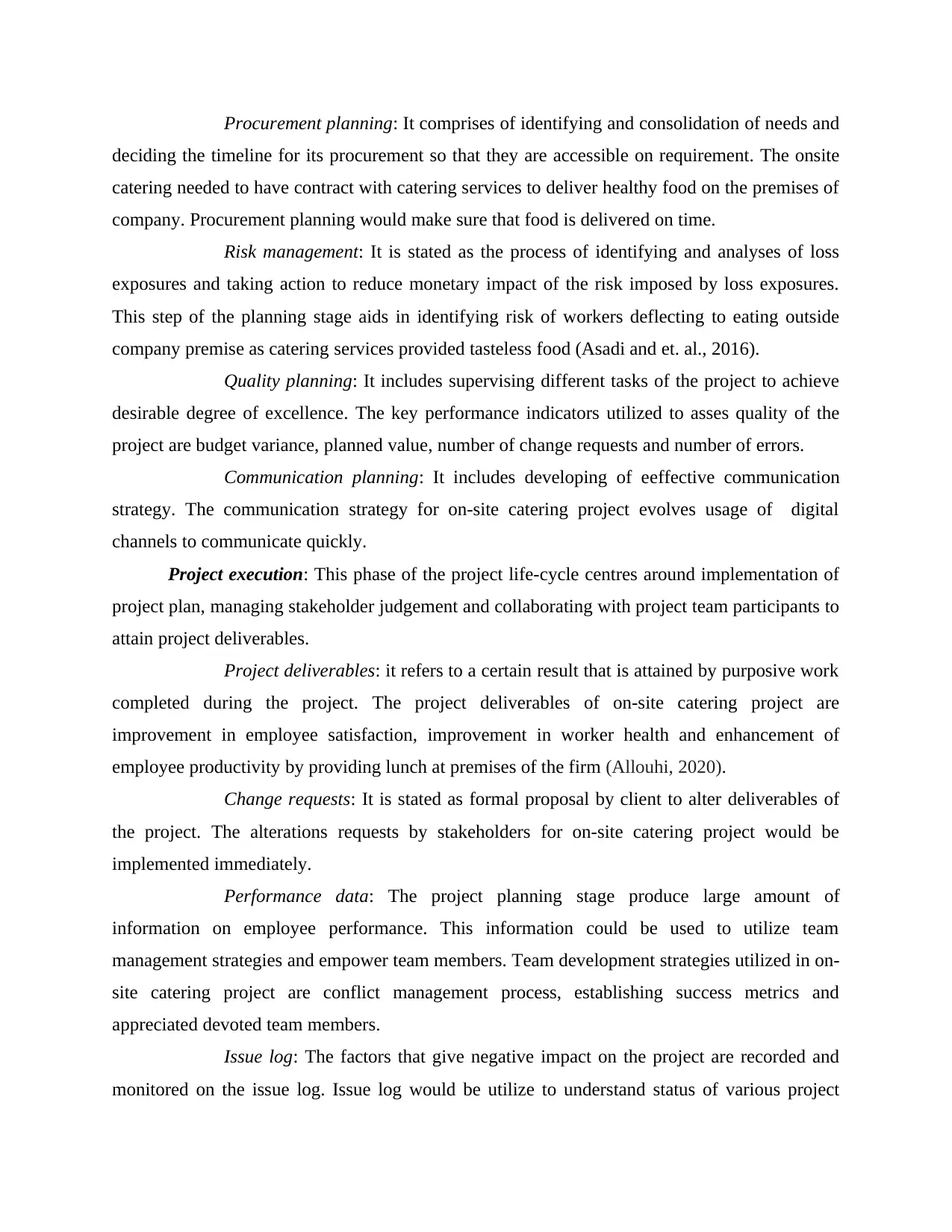
Procurement planning: It comprises of identifying and consolidation of needs and
deciding the timeline for its procurement so that they are accessible on requirement. The onsite
catering needed to have contract with catering services to deliver healthy food on the premises of
company. Procurement planning would make sure that food is delivered on time.
Risk management: It is stated as the process of identifying and analyses of loss
exposures and taking action to reduce monetary impact of the risk imposed by loss exposures.
This step of the planning stage aids in identifying risk of workers deflecting to eating outside
company premise as catering services provided tasteless food (Asadi and et. al., 2016).
Quality planning: It includes supervising different tasks of the project to achieve
desirable degree of excellence. The key performance indicators utilized to asses quality of the
project are budget variance, planned value, number of change requests and number of errors.
Communication planning: It includes developing of eeffective communication
strategy. The communication strategy for on-site catering project evolves usage of digital
channels to communicate quickly.
Project execution: This phase of the project life-cycle centres around implementation of
project plan, managing stakeholder judgement and collaborating with project team participants to
attain project deliverables.
Project deliverables: it refers to a certain result that is attained by purposive work
completed during the project. The project deliverables of on-site catering project are
improvement in employee satisfaction, improvement in worker health and enhancement of
employee productivity by providing lunch at premises of the firm (Allouhi, 2020).
Change requests: It is stated as formal proposal by client to alter deliverables of
the project. The alterations requests by stakeholders for on-site catering project would be
implemented immediately.
Performance data: The project planning stage produce large amount of
information on employee performance. This information could be used to utilize team
management strategies and empower team members. Team development strategies utilized in on-
site catering project are conflict management process, establishing success metrics and
appreciated devoted team members.
Issue log: The factors that give negative impact on the project are recorded and
monitored on the issue log. Issue log would be utilize to understand status of various project
deciding the timeline for its procurement so that they are accessible on requirement. The onsite
catering needed to have contract with catering services to deliver healthy food on the premises of
company. Procurement planning would make sure that food is delivered on time.
Risk management: It is stated as the process of identifying and analyses of loss
exposures and taking action to reduce monetary impact of the risk imposed by loss exposures.
This step of the planning stage aids in identifying risk of workers deflecting to eating outside
company premise as catering services provided tasteless food (Asadi and et. al., 2016).
Quality planning: It includes supervising different tasks of the project to achieve
desirable degree of excellence. The key performance indicators utilized to asses quality of the
project are budget variance, planned value, number of change requests and number of errors.
Communication planning: It includes developing of eeffective communication
strategy. The communication strategy for on-site catering project evolves usage of digital
channels to communicate quickly.
Project execution: This phase of the project life-cycle centres around implementation of
project plan, managing stakeholder judgement and collaborating with project team participants to
attain project deliverables.
Project deliverables: it refers to a certain result that is attained by purposive work
completed during the project. The project deliverables of on-site catering project are
improvement in employee satisfaction, improvement in worker health and enhancement of
employee productivity by providing lunch at premises of the firm (Allouhi, 2020).
Change requests: It is stated as formal proposal by client to alter deliverables of
the project. The alterations requests by stakeholders for on-site catering project would be
implemented immediately.
Performance data: The project planning stage produce large amount of
information on employee performance. This information could be used to utilize team
management strategies and empower team members. Team development strategies utilized in on-
site catering project are conflict management process, establishing success metrics and
appreciated devoted team members.
Issue log: The factors that give negative impact on the project are recorded and
monitored on the issue log. Issue log would be utilize to understand status of various project
Paraphrase This Document
Need a fresh take? Get an instant paraphrase of this document with our AI Paraphraser
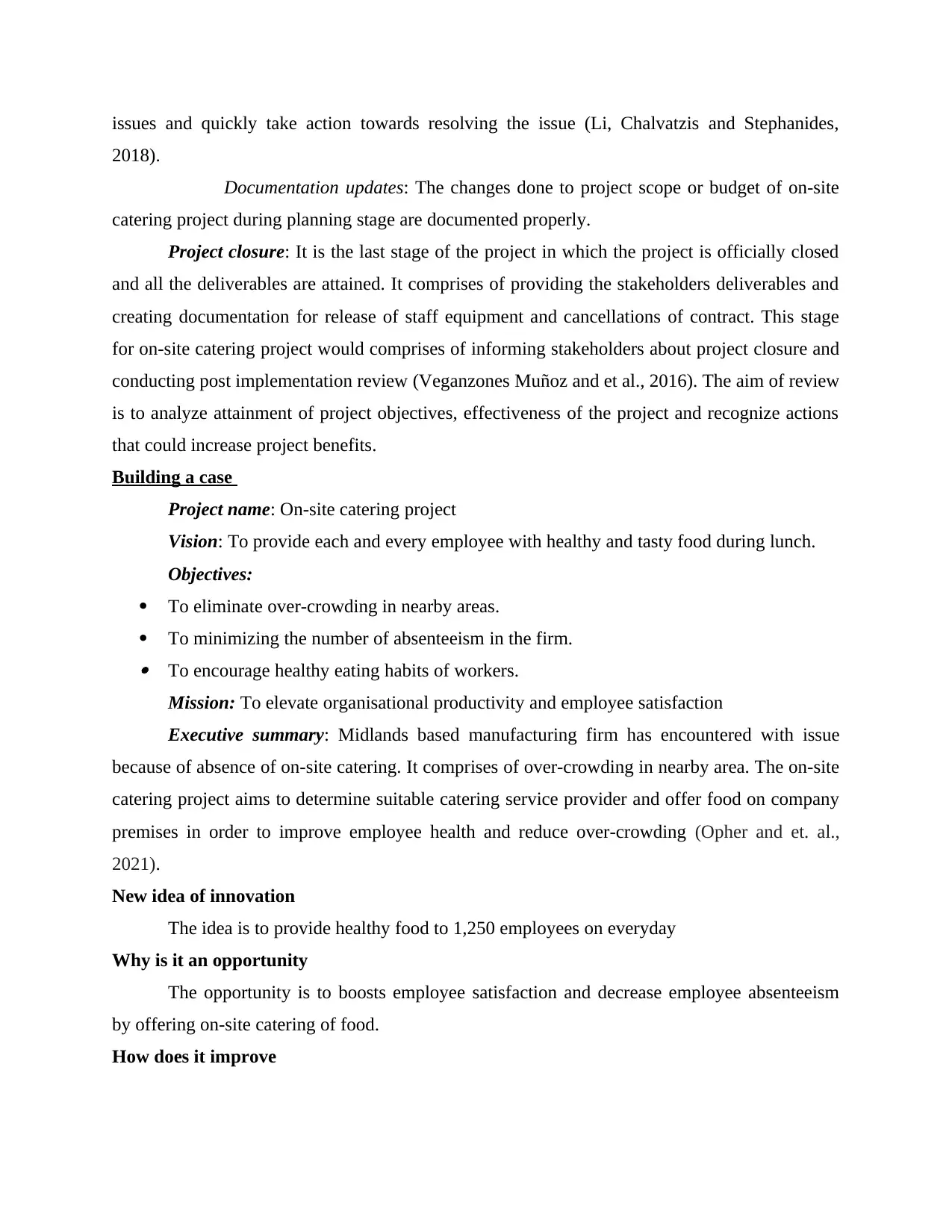
issues and quickly take action towards resolving the issue (Li, Chalvatzis and Stephanides,
2018).
Documentation updates: The changes done to project scope or budget of on-site
catering project during planning stage are documented properly.
Project closure: It is the last stage of the project in which the project is officially closed
and all the deliverables are attained. It comprises of providing the stakeholders deliverables and
creating documentation for release of staff equipment and cancellations of contract. This stage
for on-site catering project would comprises of informing stakeholders about project closure and
conducting post implementation review (Veganzones Muñoz and et al., 2016). The aim of review
is to analyze attainment of project objectives, effectiveness of the project and recognize actions
that could increase project benefits.
Building a case
Project name: On-site catering project
Vision: To provide each and every employee with healthy and tasty food during lunch.
Objectives:
To eliminate over-crowding in nearby areas.
To minimizing the number of absenteeism in the firm. To encourage healthy eating habits of workers.
Mission: To elevate organisational productivity and employee satisfaction
Executive summary: Midlands based manufacturing firm has encountered with issue
because of absence of on-site catering. It comprises of over-crowding in nearby area. The on-site
catering project aims to determine suitable catering service provider and offer food on company
premises in order to improve employee health and reduce over-crowding (Opher and et. al.,
2021).
New idea of innovation
The idea is to provide healthy food to 1,250 employees on everyday
Why is it an opportunity
The opportunity is to boosts employee satisfaction and decrease employee absenteeism
by offering on-site catering of food.
How does it improve
2018).
Documentation updates: The changes done to project scope or budget of on-site
catering project during planning stage are documented properly.
Project closure: It is the last stage of the project in which the project is officially closed
and all the deliverables are attained. It comprises of providing the stakeholders deliverables and
creating documentation for release of staff equipment and cancellations of contract. This stage
for on-site catering project would comprises of informing stakeholders about project closure and
conducting post implementation review (Veganzones Muñoz and et al., 2016). The aim of review
is to analyze attainment of project objectives, effectiveness of the project and recognize actions
that could increase project benefits.
Building a case
Project name: On-site catering project
Vision: To provide each and every employee with healthy and tasty food during lunch.
Objectives:
To eliminate over-crowding in nearby areas.
To minimizing the number of absenteeism in the firm. To encourage healthy eating habits of workers.
Mission: To elevate organisational productivity and employee satisfaction
Executive summary: Midlands based manufacturing firm has encountered with issue
because of absence of on-site catering. It comprises of over-crowding in nearby area. The on-site
catering project aims to determine suitable catering service provider and offer food on company
premises in order to improve employee health and reduce over-crowding (Opher and et. al.,
2021).
New idea of innovation
The idea is to provide healthy food to 1,250 employees on everyday
Why is it an opportunity
The opportunity is to boosts employee satisfaction and decrease employee absenteeism
by offering on-site catering of food.
How does it improve
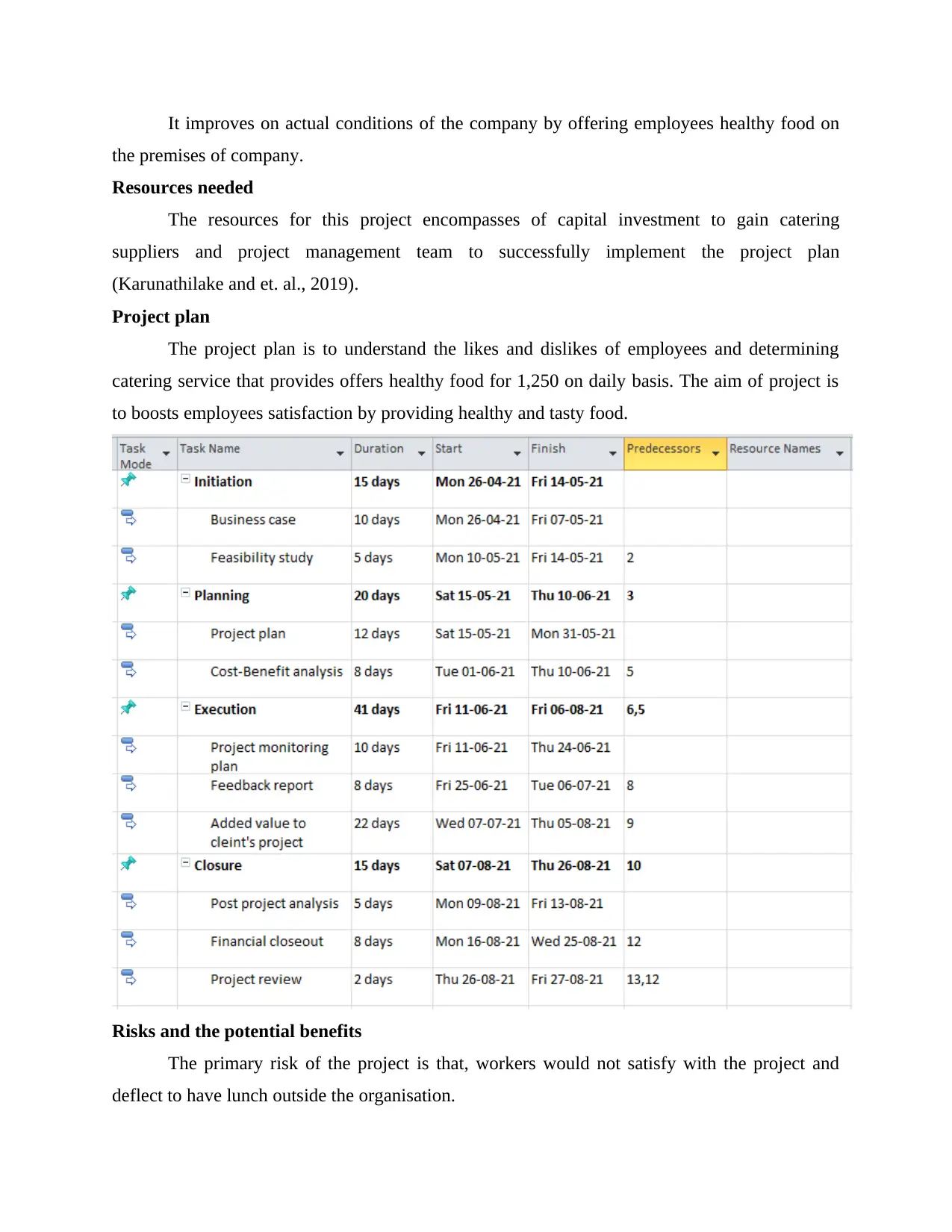
It improves on actual conditions of the company by offering employees healthy food on
the premises of company.
Resources needed
The resources for this project encompasses of capital investment to gain catering
suppliers and project management team to successfully implement the project plan
(Karunathilake and et. al., 2019).
Project plan
The project plan is to understand the likes and dislikes of employees and determining
catering service that provides offers healthy food for 1,250 on daily basis. The aim of project is
to boosts employees satisfaction by providing healthy and tasty food.
Risks and the potential benefits
The primary risk of the project is that, workers would not satisfy with the project and
deflect to have lunch outside the organisation.
the premises of company.
Resources needed
The resources for this project encompasses of capital investment to gain catering
suppliers and project management team to successfully implement the project plan
(Karunathilake and et. al., 2019).
Project plan
The project plan is to understand the likes and dislikes of employees and determining
catering service that provides offers healthy food for 1,250 on daily basis. The aim of project is
to boosts employees satisfaction by providing healthy and tasty food.
Risks and the potential benefits
The primary risk of the project is that, workers would not satisfy with the project and
deflect to have lunch outside the organisation.
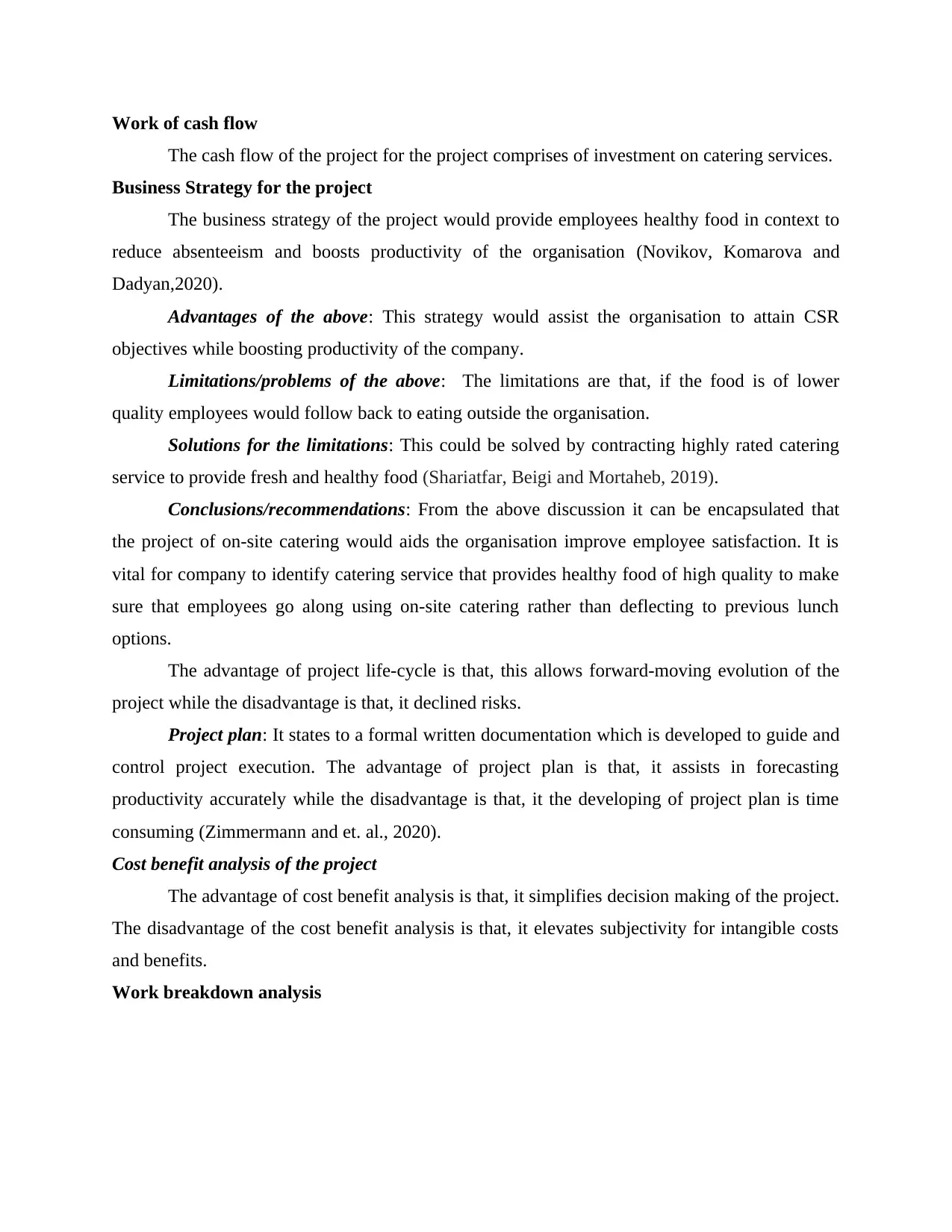
Work of cash flow
The cash flow of the project for the project comprises of investment on catering services.
Business Strategy for the project
The business strategy of the project would provide employees healthy food in context to
reduce absenteeism and boosts productivity of the organisation (Novikov, Komarova and
Dadyan,2020).
Advantages of the above: This strategy would assist the organisation to attain CSR
objectives while boosting productivity of the company.
Limitations/problems of the above: The limitations are that, if the food is of lower
quality employees would follow back to eating outside the organisation.
Solutions for the limitations: This could be solved by contracting highly rated catering
service to provide fresh and healthy food (Shariatfar, Beigi and Mortaheb, 2019).
Conclusions/recommendations: From the above discussion it can be encapsulated that
the project of on-site catering would aids the organisation improve employee satisfaction. It is
vital for company to identify catering service that provides healthy food of high quality to make
sure that employees go along using on-site catering rather than deflecting to previous lunch
options.
The advantage of project life-cycle is that, this allows forward-moving evolution of the
project while the disadvantage is that, it declined risks.
Project plan: It states to a formal written documentation which is developed to guide and
control project execution. The advantage of project plan is that, it assists in forecasting
productivity accurately while the disadvantage is that, it the developing of project plan is time
consuming (Zimmermann and et. al., 2020).
Cost benefit analysis of the project
The advantage of cost benefit analysis is that, it simplifies decision making of the project.
The disadvantage of the cost benefit analysis is that, it elevates subjectivity for intangible costs
and benefits.
Work breakdown analysis
The cash flow of the project for the project comprises of investment on catering services.
Business Strategy for the project
The business strategy of the project would provide employees healthy food in context to
reduce absenteeism and boosts productivity of the organisation (Novikov, Komarova and
Dadyan,2020).
Advantages of the above: This strategy would assist the organisation to attain CSR
objectives while boosting productivity of the company.
Limitations/problems of the above: The limitations are that, if the food is of lower
quality employees would follow back to eating outside the organisation.
Solutions for the limitations: This could be solved by contracting highly rated catering
service to provide fresh and healthy food (Shariatfar, Beigi and Mortaheb, 2019).
Conclusions/recommendations: From the above discussion it can be encapsulated that
the project of on-site catering would aids the organisation improve employee satisfaction. It is
vital for company to identify catering service that provides healthy food of high quality to make
sure that employees go along using on-site catering rather than deflecting to previous lunch
options.
The advantage of project life-cycle is that, this allows forward-moving evolution of the
project while the disadvantage is that, it declined risks.
Project plan: It states to a formal written documentation which is developed to guide and
control project execution. The advantage of project plan is that, it assists in forecasting
productivity accurately while the disadvantage is that, it the developing of project plan is time
consuming (Zimmermann and et. al., 2020).
Cost benefit analysis of the project
The advantage of cost benefit analysis is that, it simplifies decision making of the project.
The disadvantage of the cost benefit analysis is that, it elevates subjectivity for intangible costs
and benefits.
Work breakdown analysis
Secure Best Marks with AI Grader
Need help grading? Try our AI Grader for instant feedback on your assignments.
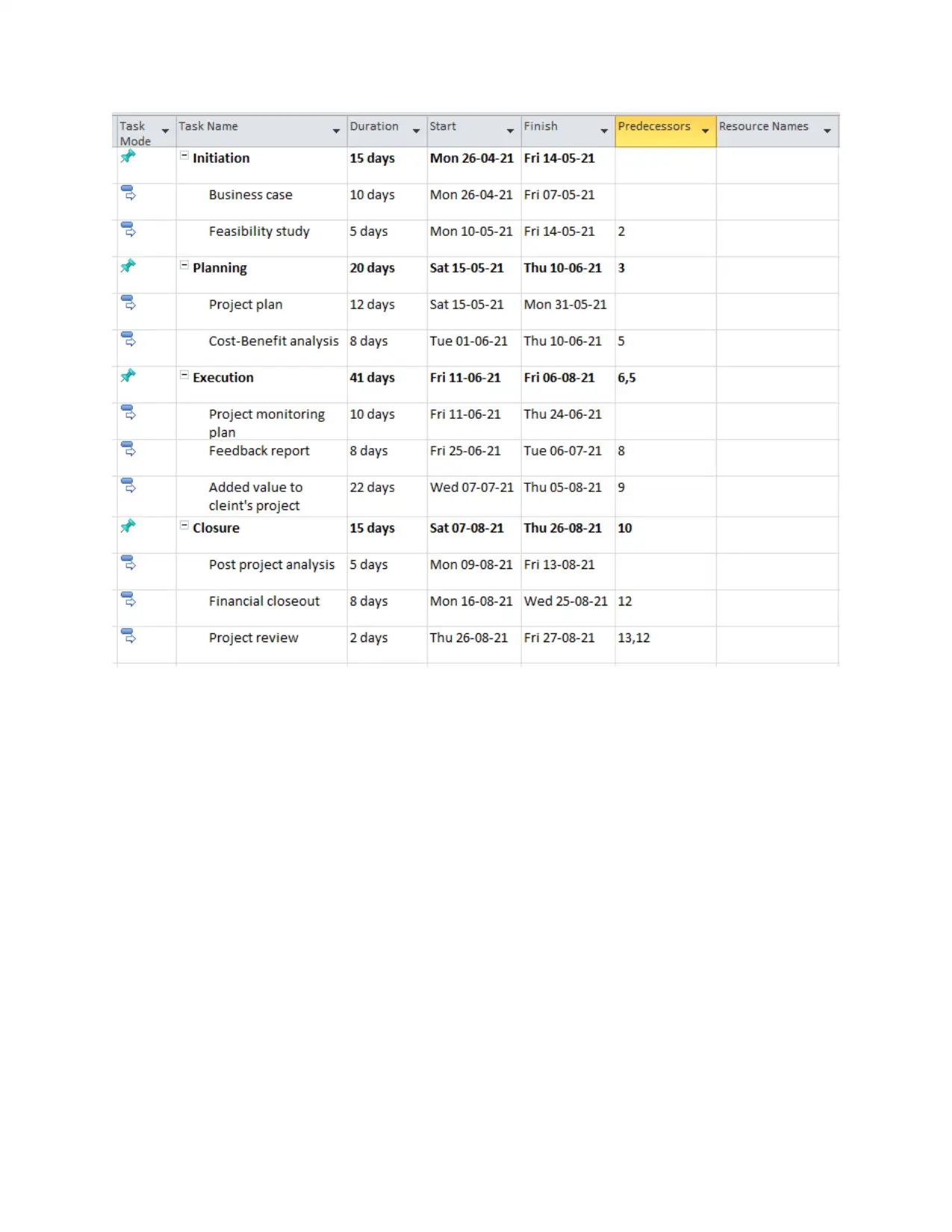
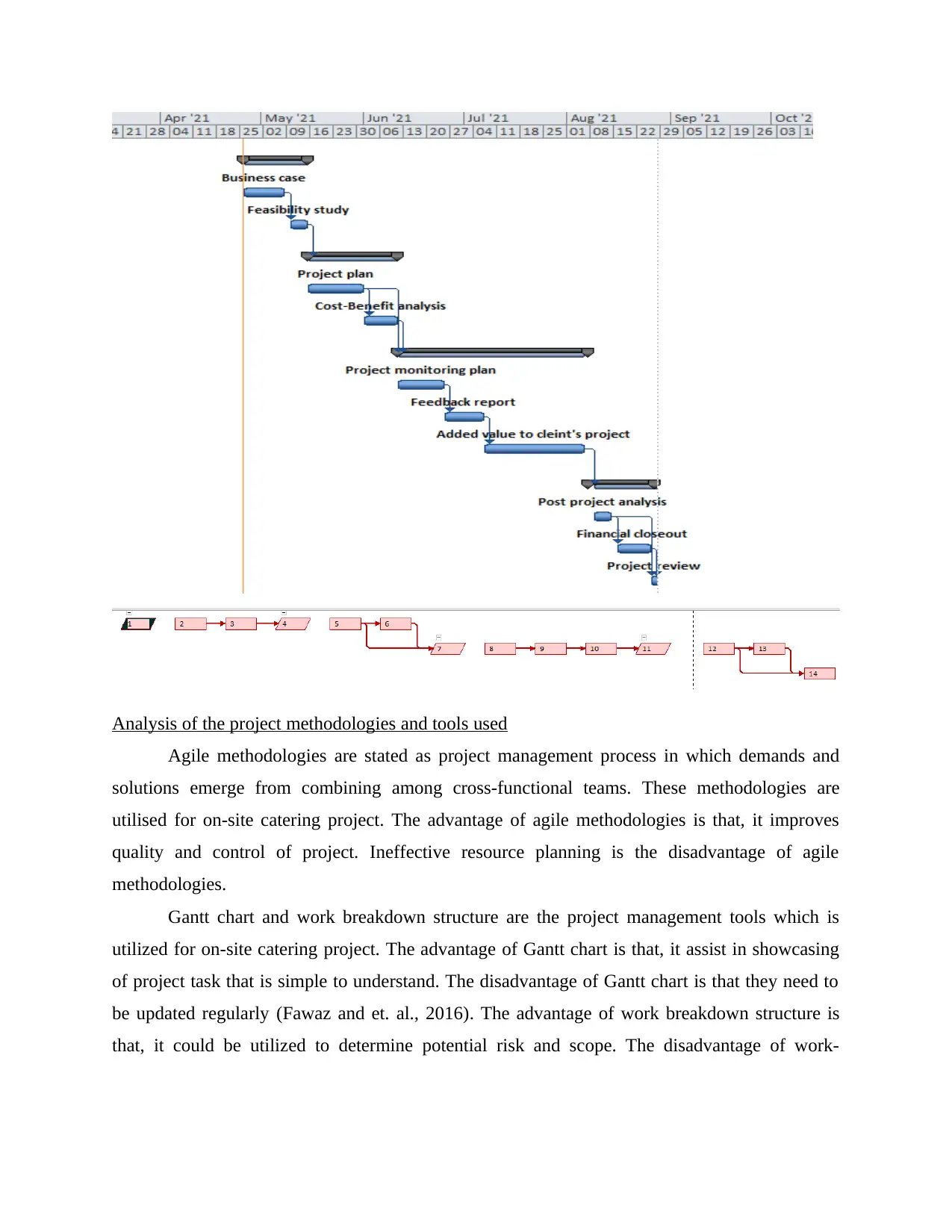
Analysis of the project methodologies and tools used
Agile methodologies are stated as project management process in which demands and
solutions emerge from combining among cross-functional teams. These methodologies are
utilised for on-site catering project. The advantage of agile methodologies is that, it improves
quality and control of project. Ineffective resource planning is the disadvantage of agile
methodologies.
Gantt chart and work breakdown structure are the project management tools which is
utilized for on-site catering project. The advantage of Gantt chart is that, it assist in showcasing
of project task that is simple to understand. The disadvantage of Gantt chart is that they need to
be updated regularly (Fawaz and et. al., 2016). The advantage of work breakdown structure is
that, it could be utilized to determine potential risk and scope. The disadvantage of work-
Agile methodologies are stated as project management process in which demands and
solutions emerge from combining among cross-functional teams. These methodologies are
utilised for on-site catering project. The advantage of agile methodologies is that, it improves
quality and control of project. Ineffective resource planning is the disadvantage of agile
methodologies.
Gantt chart and work breakdown structure are the project management tools which is
utilized for on-site catering project. The advantage of Gantt chart is that, it assist in showcasing
of project task that is simple to understand. The disadvantage of Gantt chart is that they need to
be updated regularly (Fawaz and et. al., 2016). The advantage of work breakdown structure is
that, it could be utilized to determine potential risk and scope. The disadvantage of work-
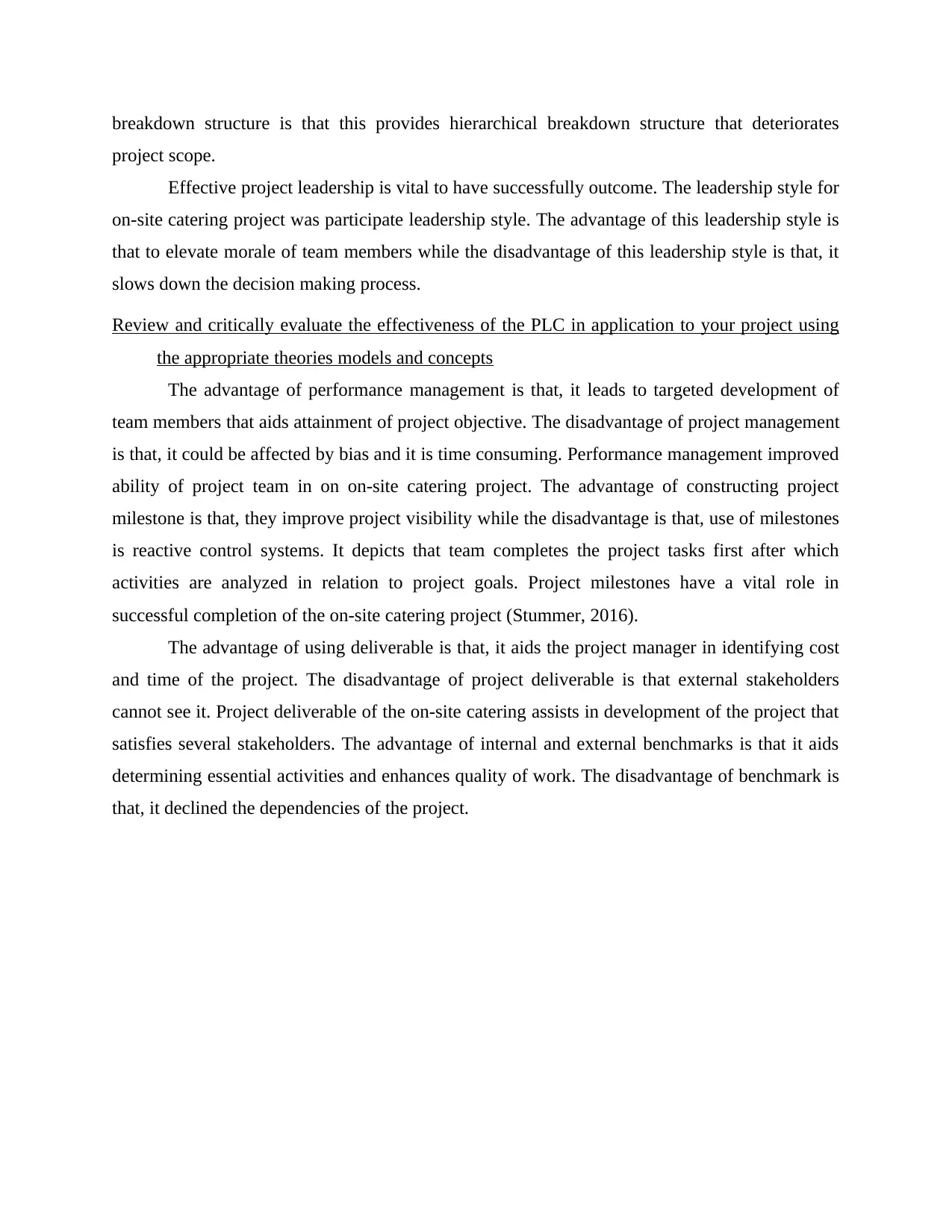
breakdown structure is that this provides hierarchical breakdown structure that deteriorates
project scope.
Effective project leadership is vital to have successfully outcome. The leadership style for
on-site catering project was participate leadership style. The advantage of this leadership style is
that to elevate morale of team members while the disadvantage of this leadership style is that, it
slows down the decision making process.
Review and critically evaluate the effectiveness of the PLC in application to your project using
the appropriate theories models and concepts
The advantage of performance management is that, it leads to targeted development of
team members that aids attainment of project objective. The disadvantage of project management
is that, it could be affected by bias and it is time consuming. Performance management improved
ability of project team in on on-site catering project. The advantage of constructing project
milestone is that, they improve project visibility while the disadvantage is that, use of milestones
is reactive control systems. It depicts that team completes the project tasks first after which
activities are analyzed in relation to project goals. Project milestones have a vital role in
successful completion of the on-site catering project (Stummer, 2016).
The advantage of using deliverable is that, it aids the project manager in identifying cost
and time of the project. The disadvantage of project deliverable is that external stakeholders
cannot see it. Project deliverable of the on-site catering assists in development of the project that
satisfies several stakeholders. The advantage of internal and external benchmarks is that it aids
determining essential activities and enhances quality of work. The disadvantage of benchmark is
that, it declined the dependencies of the project.
project scope.
Effective project leadership is vital to have successfully outcome. The leadership style for
on-site catering project was participate leadership style. The advantage of this leadership style is
that to elevate morale of team members while the disadvantage of this leadership style is that, it
slows down the decision making process.
Review and critically evaluate the effectiveness of the PLC in application to your project using
the appropriate theories models and concepts
The advantage of performance management is that, it leads to targeted development of
team members that aids attainment of project objective. The disadvantage of project management
is that, it could be affected by bias and it is time consuming. Performance management improved
ability of project team in on on-site catering project. The advantage of constructing project
milestone is that, they improve project visibility while the disadvantage is that, use of milestones
is reactive control systems. It depicts that team completes the project tasks first after which
activities are analyzed in relation to project goals. Project milestones have a vital role in
successful completion of the on-site catering project (Stummer, 2016).
The advantage of using deliverable is that, it aids the project manager in identifying cost
and time of the project. The disadvantage of project deliverable is that external stakeholders
cannot see it. Project deliverable of the on-site catering assists in development of the project that
satisfies several stakeholders. The advantage of internal and external benchmarks is that it aids
determining essential activities and enhances quality of work. The disadvantage of benchmark is
that, it declined the dependencies of the project.
Paraphrase This Document
Need a fresh take? Get an instant paraphrase of this document with our AI Paraphraser
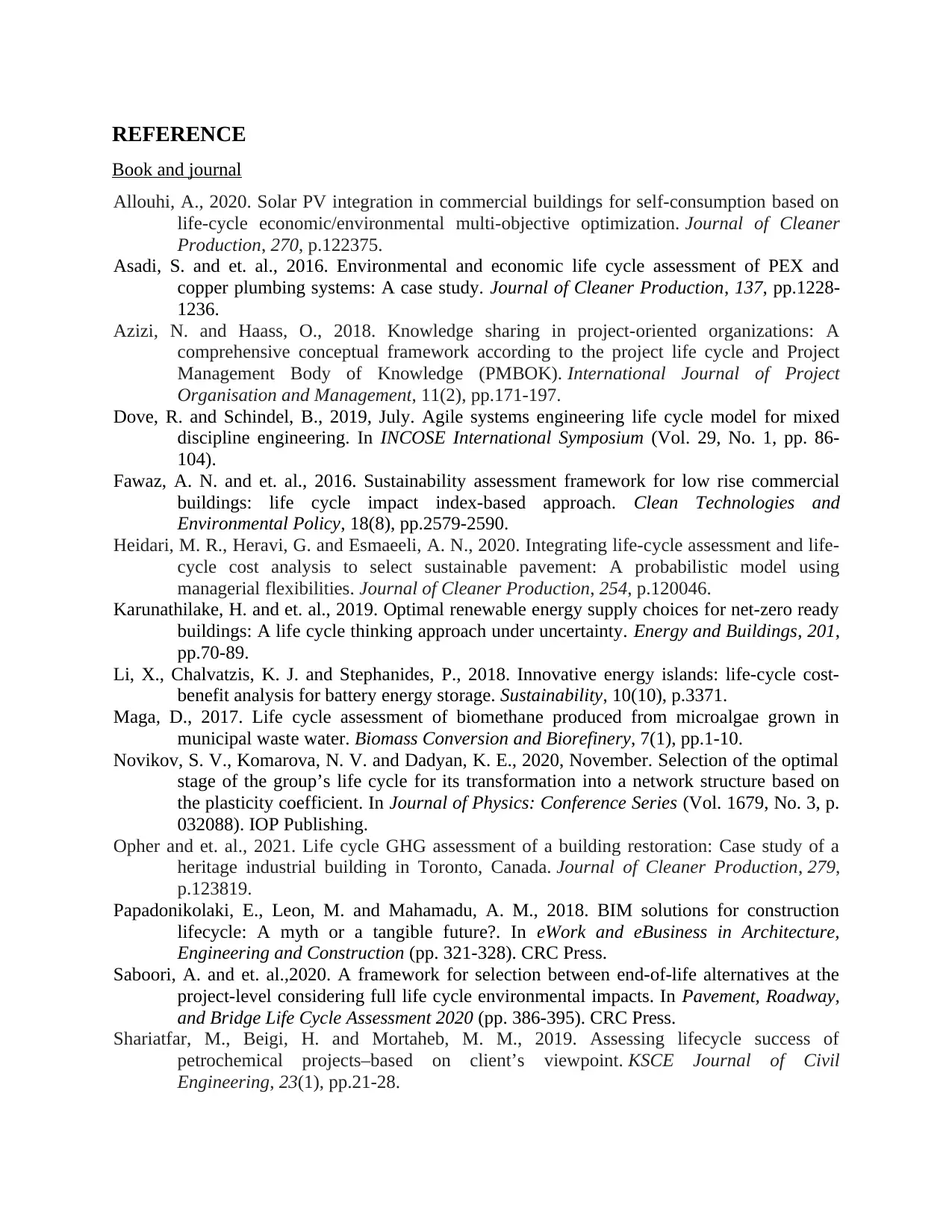
REFERENCE
Book and journal
Allouhi, A., 2020. Solar PV integration in commercial buildings for self-consumption based on
life-cycle economic/environmental multi-objective optimization. Journal of Cleaner
Production, 270, p.122375.
Asadi, S. and et. al., 2016. Environmental and economic life cycle assessment of PEX and
copper plumbing systems: A case study. Journal of Cleaner Production, 137, pp.1228-
1236.
Azizi, N. and Haass, O., 2018. Knowledge sharing in project-oriented organizations: A
comprehensive conceptual framework according to the project life cycle and Project
Management Body of Knowledge (PMBOK). International Journal of Project
Organisation and Management, 11(2), pp.171-197.
Dove, R. and Schindel, B., 2019, July. Agile systems engineering life cycle model for mixed
discipline engineering. In INCOSE International Symposium (Vol. 29, No. 1, pp. 86-
104).
Fawaz, A. N. and et. al., 2016. Sustainability assessment framework for low rise commercial
buildings: life cycle impact index-based approach. Clean Technologies and
Environmental Policy, 18(8), pp.2579-2590.
Heidari, M. R., Heravi, G. and Esmaeeli, A. N., 2020. Integrating life-cycle assessment and life-
cycle cost analysis to select sustainable pavement: A probabilistic model using
managerial flexibilities. Journal of Cleaner Production, 254, p.120046.
Karunathilake, H. and et. al., 2019. Optimal renewable energy supply choices for net-zero ready
buildings: A life cycle thinking approach under uncertainty. Energy and Buildings, 201,
pp.70-89.
Li, X., Chalvatzis, K. J. and Stephanides, P., 2018. Innovative energy islands: life-cycle cost-
benefit analysis for battery energy storage. Sustainability, 10(10), p.3371.
Maga, D., 2017. Life cycle assessment of biomethane produced from microalgae grown in
municipal waste water. Biomass Conversion and Biorefinery, 7(1), pp.1-10.
Novikov, S. V., Komarova, N. V. and Dadyan, K. E., 2020, November. Selection of the optimal
stage of the group’s life cycle for its transformation into a network structure based on
the plasticity coefficient. In Journal of Physics: Conference Series (Vol. 1679, No. 3, p.
032088). IOP Publishing.
Opher and et. al., 2021. Life cycle GHG assessment of a building restoration: Case study of a
heritage industrial building in Toronto, Canada. Journal of Cleaner Production, 279,
p.123819.
Papadonikolaki, E., Leon, M. and Mahamadu, A. M., 2018. BIM solutions for construction
lifecycle: A myth or a tangible future?. In eWork and eBusiness in Architecture,
Engineering and Construction (pp. 321-328). CRC Press.
Saboori, A. and et. al.,2020. A framework for selection between end-of-life alternatives at the
project-level considering full life cycle environmental impacts. In Pavement, Roadway,
and Bridge Life Cycle Assessment 2020 (pp. 386-395). CRC Press.
Shariatfar, M., Beigi, H. and Mortaheb, M. M., 2019. Assessing lifecycle success of
petrochemical projects–based on client’s viewpoint. KSCE Journal of Civil
Engineering, 23(1), pp.21-28.
Book and journal
Allouhi, A., 2020. Solar PV integration in commercial buildings for self-consumption based on
life-cycle economic/environmental multi-objective optimization. Journal of Cleaner
Production, 270, p.122375.
Asadi, S. and et. al., 2016. Environmental and economic life cycle assessment of PEX and
copper plumbing systems: A case study. Journal of Cleaner Production, 137, pp.1228-
1236.
Azizi, N. and Haass, O., 2018. Knowledge sharing in project-oriented organizations: A
comprehensive conceptual framework according to the project life cycle and Project
Management Body of Knowledge (PMBOK). International Journal of Project
Organisation and Management, 11(2), pp.171-197.
Dove, R. and Schindel, B., 2019, July. Agile systems engineering life cycle model for mixed
discipline engineering. In INCOSE International Symposium (Vol. 29, No. 1, pp. 86-
104).
Fawaz, A. N. and et. al., 2016. Sustainability assessment framework for low rise commercial
buildings: life cycle impact index-based approach. Clean Technologies and
Environmental Policy, 18(8), pp.2579-2590.
Heidari, M. R., Heravi, G. and Esmaeeli, A. N., 2020. Integrating life-cycle assessment and life-
cycle cost analysis to select sustainable pavement: A probabilistic model using
managerial flexibilities. Journal of Cleaner Production, 254, p.120046.
Karunathilake, H. and et. al., 2019. Optimal renewable energy supply choices for net-zero ready
buildings: A life cycle thinking approach under uncertainty. Energy and Buildings, 201,
pp.70-89.
Li, X., Chalvatzis, K. J. and Stephanides, P., 2018. Innovative energy islands: life-cycle cost-
benefit analysis for battery energy storage. Sustainability, 10(10), p.3371.
Maga, D., 2017. Life cycle assessment of biomethane produced from microalgae grown in
municipal waste water. Biomass Conversion and Biorefinery, 7(1), pp.1-10.
Novikov, S. V., Komarova, N. V. and Dadyan, K. E., 2020, November. Selection of the optimal
stage of the group’s life cycle for its transformation into a network structure based on
the plasticity coefficient. In Journal of Physics: Conference Series (Vol. 1679, No. 3, p.
032088). IOP Publishing.
Opher and et. al., 2021. Life cycle GHG assessment of a building restoration: Case study of a
heritage industrial building in Toronto, Canada. Journal of Cleaner Production, 279,
p.123819.
Papadonikolaki, E., Leon, M. and Mahamadu, A. M., 2018. BIM solutions for construction
lifecycle: A myth or a tangible future?. In eWork and eBusiness in Architecture,
Engineering and Construction (pp. 321-328). CRC Press.
Saboori, A. and et. al.,2020. A framework for selection between end-of-life alternatives at the
project-level considering full life cycle environmental impacts. In Pavement, Roadway,
and Bridge Life Cycle Assessment 2020 (pp. 386-395). CRC Press.
Shariatfar, M., Beigi, H. and Mortaheb, M. M., 2019. Assessing lifecycle success of
petrochemical projects–based on client’s viewpoint. KSCE Journal of Civil
Engineering, 23(1), pp.21-28.

Stummer, R., 2016. A common sense approach to asset and project lifecycle management.
Construction Engineering Australia, 2(3), p.27.
Veganzones Muñoz, J. J. and et al., 2016. Life-cycle cost analysis as a tool in the developing
process for new bridge edge beam solutions. Structure and Infrastructure Engineering,
12(9), pp.1185-1201.
Zimmermann, A.,and et. al., 2020. Techno-Economic Assessment & Life Cycle Assessment
Guidelines for CO2 Utilization (Version 1.1).
Construction Engineering Australia, 2(3), p.27.
Veganzones Muñoz, J. J. and et al., 2016. Life-cycle cost analysis as a tool in the developing
process for new bridge edge beam solutions. Structure and Infrastructure Engineering,
12(9), pp.1185-1201.
Zimmermann, A.,and et. al., 2020. Techno-Economic Assessment & Life Cycle Assessment
Guidelines for CO2 Utilization (Version 1.1).
1 out of 21
Related Documents
Your All-in-One AI-Powered Toolkit for Academic Success.
+13062052269
info@desklib.com
Available 24*7 on WhatsApp / Email
![[object Object]](/_next/static/media/star-bottom.7253800d.svg)
Unlock your academic potential
© 2024 | Zucol Services PVT LTD | All rights reserved.



